Title 51
PUBLIC HEALTH―SANITARY CODE
Part XIII. Sewage Disposal
Chapter 1. General
[formerly Chapter 13 Subpart A]
§101. Definitions
[formerly paragraph 13:001]
A. As used in this Part, the terms defined in this
Chapter supplement any definitions which may be set
forth in law and shall have the following meanings
and/or applications, unless the context or use thereof
clearly indicates otherwise, or more explicit definitions
and/or applications are referenced. Terms not defined or
referenced herein shall have the meanings as defined in
the other Parts of the sanitary code of the state of
Louisiana. In any instance where a term defined herein is
also defined in one or more other Parts of this Code, the
definition contained in this Part shall be given preference
as it pertains to sewage disposal.
Commercial Treatment Facility (designed in
accordance with §503)―any treatment facility which is
required by the state health officer whenever the use of
an individual sewerage system is unfeasible or not
authorized.
Community Sewerage System―any sewerage system
which serves multiple connections and consists of a
collection and/or pumping/transport system and
treatment facility.
Conventional Septic Tank System―a septic tank
system which consists of a septic tank(s) followed by a
subsurface absorption field.
Facility or Facilities―any or all of the apparatus and
appurtenances associated with a sanitary sewage
treatment system, element, or process.
Gravelless Pipe―a proprietary device which may be
used in lieu of conventional subsurface absorption field
materials when approved by the state health officer.
Individual Mechanical Plant―a treatment facility
which provides primary and secondary treatment of
sanitary sewage by use of aerobic bacterial action which
is sustained by mechanical means.
Individual Sewerage System―any system of piping
(excluding the building drain), and/or collection and/or
transport system which serves one or more connections,
and/or pumping facility, and treatment facility, all located
on the property where the sanitary sewage
originates; and which utilizes the individual
sewerage system technology which is set forth in
Chapter 7 Subchapter B of this Part, or a commercial
treatment facility which is specifically authorized for
use by the state health officer.
Limited Use Sewerage System―a sewerage
system which may be authorized by the state health
officer for installation or use for a structure or
dwelling which is occupied less than four days in a
week, and the use of which generates less than 100
GPD of sanitary sewage.
Manufacturer―a person who engages in the
business or practice of constructing individual
mechanical sewerage treatment systems, and who
is responsible for having the system evaluated in
compliance with §725.D of this Part.
Person―any natural person, partnership,
corporation, association, governmental subdivision,
receiver, tutor, curator, executor, administrator,
fiduciary, or representative of another person, or
public or private organization of any character.
Premises―any structure or dwelling of any
construction whatsoever in which a person may live,
work, or congregate.
Sanitary Sewage―any and all human waste
and/or domestic waste, the disposal of which
requires a sewerage system approved or authorized
by the state health officer. Sanitary sewage may
include its conveying liquid and/or any other liquid
or solid material which may be present therein.
Secondary Treatment Standard―a sewage
effluent water quality standard which prescribes a
maximum 30-day average concentration of
biochemical oxygen demand (5-day basis) of 30
milligrams per liter (mg/l), and a maximum daily
concentration of biochemical oxygen demand (5-day
basis) of 45 mg/l. The 30-day average concentration
is an arithmetic mean of the values for all effluent
samples collected in the sampling period. The
analyses to be performed for the purpose of
determining compliance with these effluent
limitations and standards shall be in accordance with the
eighteenth edition of the "Standard Methods for the
Examination of Water and Wastewater," available from
the American Public Health Association 1015 Eighteenth
Street NW, Washington, D.C. 20036, except where
otherwise specified.
Septic Tank System―an individual sewerage system
which consists of a septic tank(s) followed by a process
which treats and disposes of the septic tank effluent.
Sewerage System―any system of piping (excluding
the building drain and building sewer) and/or collection
and/or transport system and/or pumping facility and/or
treatment facility, all for the purpose of collecting,
transporting, pumping, treating and/or disposing of
sanitary sewage.
Subdivision for the purpose of these regulations―
a. the division, or the process or results thereof,
of any land into two or more lots, tracts, parcels, or
plots, any one of which has an area of less than 3 acres;
or
b. the re-subdivision of land heretofore divided
into lots, tracts, sites or parcels; provided, however, that
minimum lot size restrictions presented in §511.B shall
not apply to:
i. a subdivision legally established and
recorded prior to July 28, 1967; or
ii. a small parcel of land sold to or exchanged
between adjoining property owners, provided that such
a sale or exchange does not create additional lots.
c. Note: For the purpose of these regulations, the
requirements for wetlands might be more stringent.
Sub-Manufacturer―a person or entity authorized by
a licensed manufacturer to construct, or assemble
individual sewerage systems, or any portion thereof.
Trailer Coach―any of the various forms of structures
which are equipped, or capable of being equipped, with
wheels, including, but not limited to, travel trailers, truck
coaches or campers, mobile homes, trailers, and/or tent
campers, whether capable of moving under its own
power or not, and where a person or persons may live,
work, or congregate.
Trailer Park―any lot, tract, parcel or plot of land
upon which more than one trailer coach is or may be
located, and where trailer coach spaces are rented or
leased.
AUTHORITY NOTE: The first source of authority for
promulgation of the sanitary code is in R.S. 36:258(B), with
more particular provisions found in Chapters 1 and 4 of Title 40
of the Louisiana Revised Statutes. This Part is Promulgated in
accordance with R.S. 40:4(A)(6) and R.S. 40:5(9)(20).
HISTORICAL NOTE: Promulgated by the Department of
Health and Hospitals, Office of Public Health, LR 28:1343 (June
2002).
Chapter 3. General Requirements for
Sewerage Disposal
[formerly Chapter 13 Subpart B]
§301. Plumbing Fixtures
[formerly paragraph 13:002]
A. All premises shall be provided with plumbing
fixtures as prescribed in Part XIV of this Code. Such
plumbing fixtures shall be connected to a
community sewerage system whenever feasible or
to an individual sewerage system which is
specifically approved for the premises by the state
health officer after it is determined that connection
to a community sewerage system is unfeasible and
that the installation and operation of an individual
sewerage system is not likely to create a nuisance or
a public health hazard.
AUTHORITY NOTE: Promulgated in accordance with R.S.
40:4(A)(6) and R.S. 40:5(9)(20).
HISTORICAL NOTE: Promulgated by the Department of
Health and Hospitals, Office of Public Health, LR 28:1344 (June
2002).
§303. Responsible Parties
[formerly paragraph 13:003]
A. A person who owns, operates, manages, or
otherwise controls any premises, shall provide for
sewage disposal in a manner which is in compliance
with this Code.
AUTHORITY NOTE: Promulgated in accordance with R.S.
40:4(A)(6) and R.S. 40:5(9)(20).
HISTORICAL NOTE: Promulgated by the Department of
Health and Hospitals, Office of Public Health, LR 28:1344 (June
2002).
§305. Discharges
[formerly paragraph 13:004-1]
A. A person shall not directly or indirectly
discharge, or allow to be discharged, the contents or
effluent from any plumbing fixtures, vault, privy,
portable toilet, or septic tank, into any road, street,
gutter, ditch, water course, body of water, or onto
the surface of the ground.
AUTHORITY NOTE: Promulgated in accordance with R.S.
40:4(A)(6) and R.S. 40:5(9)(20).
HISTORICAL NOTE: Promulgated by the Department of Health and
Hospitals, Office of Public Health, LR 28:1344 (June 2002).
§307. Installation
[formerly paragraph 13:004-2]
A. No component part of a sewerage system shall be
installed wherever contamination of a ground water
supply may occur. The location of any sewerage facility
shall not conflict with the placement requirements for a
water well which are set forth in Part XII of this Code.
AUTHORITY NOTE: Promulgated in accordance with R.S. 40:4(A)(6)
and R.S. 40:5(9)(20).
HISTORICAL NOTE: Promulgated by the Department of Health and
Hospitals, Office of Public Health, LR 28:1344 (June 2002).
§309. Previous Permits
[formerly paragraph 13:005]
A. Any permits issued, or approval of plans and
specifications granted prior to the effective date of the
1998 revisions of this Part shall remain in effect as it
relates to the design of the sewerage system, unless the
state health officer determines there exists a need for
revision of such permits or approvals.
AUTHORITY NOTE: Promulgated in accordance with R.S. 40:4(A)(6)
and R.S. 40:5(9)(20).
HISTORICAL NOTE: Promulgated by the Department of Health and
Hospitals, Office of Public Health, LR 28:1344 (June 2002).
Chapter 5. Community Sewerage
Systems
[formerly Chapter 13 Subpart C]
§501. Permits
[formerly paragraph 13:006]
A. A person shall not construct or operate a
community sewerage system, or make a modification of
an existing system which changes the system's capacity,
effluent quality, point of discharge, hydraulic or
contaminant loadings, or operation of the component
units of the system without having first obtained a
permit from the state health officer. No community
sewerage system shall be constructed, or modified to the
extent mentioned above, except in accordance with
plans and specifications for installation which have been
approved as a part of a permit issued by the state health
officer prior to the start of construction or modification.
AUTHORITY NOTE: Promulgated in accordance with R.S. 40:4(A)(6)
and R.S. 40:5(9)(20).
HISTORICAL NOTE: Promulgated by the Department of Health and
Hospitals, Office of Public Health, LR 28:1344 (June 2002).
§503. Plans
[formerly paragraph 13:007]
A. Detailed plans and specifications for the
construction or modification of a community sewerage
system for which a permit is requested shall be
submitted by the person who is the owner, his legal
agent or who has responsible charge of the
facilities. The review and approval of plans and
specifications submitted for issuance of a permit
will be made in accordance with the design
standards presented in "Recommended Standards
for Sewage Works," 1990 Edition, promulgated by
the Great Lakes and Upper Mississippi River Board
of State Sanitary Engineers and available from
Health Education Service, P.O. Box 7126, Albany,
New York 12224. Proposals which deviate
significantly from the standards must be submitted
to the state health officer with supporting
documentation.
AUTHORITY NOTE: Promulgated in accordance with R.S.
40:4(A)(6) and R.S. 40:5(9)(20).
HISTORICAL NOTE: Promulgated by the Department of
Health and Hospitals, Office of Public Health, LR 28:1344 (June
2002).
§505. Operation and Maintenance
[formerly paragraph 13:008-1]
A. All component facilities of a community
sewerage system shall, at all times, be maintained in
the same configuration as permitted, in working
order and operated efficiently to minimize upsets,
discharges of excessive pollutants, bypassing of
discharges from the system, and health hazards and
nuisances. Operator staffing and training, laboratory
and process controls, maintenance during normal
periods of equipment downtime, backup
equipment, and spare parts shall be provided as
needed to maintain continuous compliance with the
effluent limitations and standards established for
the facility by the state health officer and to avoid
any bypass or any overflow from the system.
B. [Formerly paragraph 13:008-2] Community
sewerage systems shall be operated and maintained
so as to consistently produce effluent water quality
meeting the minimum requirements of the
secondary treatment standard. Additional effluent
standards may be established by the state health
officer as needed based upon downstream uses of
receiving waters.
C. [Formerly paragraph 13:008-3] The bypass of
any raw or partially treated sewage from a
community sewerage system is prohibited, except
where unavoidable to prevent a potential threat to
Public Health and Safety or severe property
damage, and where no feasible alternatives to
bypass exist. The use of alternatives to bypassing,
such as auxiliary treatment facilities, retention of
untreated wastes, maintenance during normal periods of
equipment downtime, or installation of adequate backup
equipment shall be utilized to the maximum extent
feasible to avoid bypassing.
AUTHORITY NOTE: Promulgated in accordance with R.S. 40:4(A)(6)
and R.S. 40:5(9)(20).
HISTORICAL NOTE: Promulgated by the Department of Health and
Hospitals, Office of Public Health, LR 28:1345 (June 2002).
§507. Records
[formerly paragraph 13:009]
A. By request, copies of reports and suitable daily
analyses and records of daily operations shall be
submitted monthly to the state health officer.
AUTHORITY NOTE: Promulgated in accordance with R.S. 40:4(A)(6)
and R.S. 40:5(9)(20).
HISTORICAL NOTE: Promulgated by the Department of Health and
Hospitals, Office of Public Health, LR 28:1345 (June 2002).
§509. Land Application
[formerly paragraph 13:010]
A. No sewage sludge, or sewage treatment effluent
shall be applied to land for treatment, disposal, irrigation
or other purposes without a permit from the state health
officer. The Louisiana Department of Environmental
Quality should also be contacted regarding other
approvals or permits required by that agency for land
application projects.
AUTHORITY NOTE: Promulgated in accordance with R.S. 40:4(A)(6)
and R.S. 40:5(9)(20).
HISTORICAL NOTE: Promulgated by the Department of Health and
Hospitals, Office of Public Health, LR 28:1345 (June 2002).
§511. General Requirements
[formerly paragraph 13:011-1]
A. Connections to Community Sewerage Systems.
Where an established community sewerage system
(either public or private) is available, and there is ample
water supply, all plumbing fixtures within any structure
shall be connected to such community sewerage system.
Determination by the state health officer of the
availability of a community sewerage system shall take
into consideration, among other aspects, the separation
(both horizontal and vertical) of the structure in question
and the sewer main or lateral, political or geographic or
legally created boundaries, and the available capacity of
the sewer system.
B. [Formerly paragraph 13:011-2] Community
Sewerage System Required. Community sewerage
systems shall be provided for all new subdivisions and
developments where lots are sold or leased. The
developer/owner shall be responsible for the provision
of adequate sewage treatment and disposal. The use of
individual sewerage systems in lieu of a community
sewerage system may be authorized and will be
considered under the following circumstances.
1. In subdivisions comprised of less than 125
lots, when the developer submits a comprehensive
drainage plan as well as a proposal for restrictive
covenants which detail requirements for perpetual
maintenance of drainage. This requirement shall
apply for all new subdivisions and developments.
2. When the total anticipated design flow to
the sewerage system does not exceed 1,500 gpd,
and where no food service is involved as per
§1301.A.2.
3. On large lots, where an area of one acre or
more is involved, having a minimum frontage of 125
feet.
4. The installation would be located on a lot,
plot or site which has a minimum area of 22,500
square feet, and a minimum frontage of 125 feet.
5. For subdivisions when each and all lots have
a minimum area of at least 22,500 square feet and a
minimum frontage of 125 feet, except that the 125
foot frontage requirement may be waived for up to
15 percent of the total number of lots in the
development if:
a. minimum frontage on each lot in question
is not less than 60 feet, and;
b. the width of each lot in question is at
least 125 feet.
6. For parishes in which the parish governing
authority has enacted and enforces a formal sewage
permitting system (requiring approval of individual
sewage disposal systems by the state health officer
prior to issuance of any parish permits) and when
the lots or sites in question meet any of the
following criteria:
a. minimum area of 22,500 square feet and
a minimum frontage of 80 feet;
b. minimum area of 16,000 square feet and
a minimum frontage of 80 feet where an approved
individual mechanical plant is to be utilized;
c. minimum area of 12,000 square feet and
a minimum frontage of 60 feet where an approved
individual mechanical plant is utilized and is
followed by 50 feet of modified absorption field
(see Chapter 7 Subchapter B, §733.A).
7. Where lots of "record" (i.e., lots created by
formal subdivision prior to July 28, 1967) are combined
(in accord with the definition of a subdivision) to create a
new, larger, single lot, and no re-subdivision of the
property is involved. On July 20, 2002 and thereafter, in
no case shall the newly created lots have less than 50
feet of frontage or be less than 5,000 square feet in area.
8. For single lots or sites, regardless of size,
remaining in substantially developed previously
established subdivisions, when, in the opinion of the
state health officer, a hazard to the public health will not
result.
9. For single lots or sites, regardless of size, when
the installation of an individual sewerage system is
proposed in order to renovate or replace a pre-existing
sewerage system. Such installation may be allowed
when, in the opinion of the state health officer, a public
health hazard or nuisance will not result. This provision
shall apply to the renovation or replacement of pre-
existing systems only and shall not be utilized to
circumvent other requirements, particularly those
relative to minimum lot size for new residences and
subdivision development, of this code.
C. [Formerly paragraph 13:011-3] Effective October
20, 2000, this rule applies to new individual sewerage
system installations, upgrades and/or modifications to
existing systems required as a result of an investigation
by the Office of Public Health (OPH) into an allegation
that a violation of Part XIII of the Louisiana sanitary code
has occurred or is occurring, and has the potential for
causing harm or creating a nuisance to the general public
(R.S. 40:1154). Such individual sewerage systems with a
capacity up to and including 1,500 gpd, that produce
treated effluent, and which, by design, do not
significantly reduce the amount of off-site effluent, shall
be followed by an effluent reduction system constructed
as described in Chapter 7 Subchapter B, §§731 and 733
of this Part.
D. [Formerly paragraph 13:011-4] The state health
officer may consider for approval, on an individual basis,
proposals for developments that are of a unique nature,
such as a development over water, or irregular
configuration, where individual sewage disposal is
proposed, where the development, by its very nature
(e.g., where commonly or jointly owned property is
involved), is clearly not addressed by the current
considerations of this Code.
AUTHORITY NOTE: Promulgated in accordance with R.S. 40:4(A)(6),
R.S. 40:5(9)(20), and R.S. 40:1154(A).
HISTORICAL NOTE: Promulgated by the Department of
Health and Hospitals, Office of Public Health, LR 28:1345 (June
2002), amended LR 28:1591 (July 2002).
Chapter 7. Individual Sewerage
Systems
[formerly Chapter 13 Subpart D]
Subchapter A. General Requirements
§701. Permits
[formerly paragraph 13:012-1]
A. A person shall not install, cause to be
installed, alter subsequent to installation, or operate
an individual sewerage system of any kind without
first having obtained a permit from the state health
officer. No person shall install, cause to be installed,
or alter subsequent to installation an individual
sewerage system of any kind except in accordance
with the plans and specifications for the installation
which have been approved as a part of a permit
issued by the state health officer. Such permits shall
be issued in a two-stage process in accordance with
§701.B and C.
B. [Formerly paragraph 13:012-2] Upon receipt
of a request for such permit, and approval of plans
and specifications for the proposed individual
sewerage system (which shall accompany any such
request for permit), a temporary permit, authorizing
the installation of said system, may be issued. Any
such temporary permit shall be in writing and shall
not be issued until, with respect to the property and
its surroundings, the state health officer has
determined that connection to a community-type
sewerage system is not feasible, and that the
condition of the soil, drainage patterns, the lot
size/dimensions, and other related factors are such
that the construction and use of properly designed
individual sewerage facilities are not likely to create
a nuisance or public health hazard.
C. [Formerly paragraph 13:012-3] A final permit
approving the installation, shall be issued only upon
verification that the individual sewerage system has
been installed in compliance with this code. The
verification of such installation shall be determined
by means of an on-site inspection conducted by a
representative of the state health officer and/or in
the form of a completed "Certification by Installer"
form submitted to the state health officer by the
licensed installer. The installer shall notify the
appropriate local Parish Health Unit prior to the
installation of an individual sewerage system. The
sanitarian shall not issue final approval for this system
unless he/she has received a completed and signed
certification by installer form. The certification by
installer shall be submitted to the state health officer
within 15 days after completion of the installation. A
final permit shall be issued and provided to the
owner/occupant of the premises to be served by the
individual sewerage system.
D. [Formerly paragraph 13:012-4] If a consumer
currently owns, is contemplating purchasing and having
installed, or is an installer of Individual Mechanical
Sewage Treatment Plants, that consumer should be
made aware that:
1. it has become apparent that the electrical
components of Individual Mechanical Sewage Treatment
Plants which require connection to a source of electricity
may not be properly connected to that electrical source
in some cases. Specifically, mechanical sewage treatment
plants, using electrical power may require a properly
installed Ground Fault Current Interrupter (GFCI);
2. the Office of Public Health has specific statutory
authority and mandates to protect the public health
from the improper treatment and disposal of sewage.
This office will offer the public consultation with regard
to the appropriate sewage treatment system that should
be used in a specific application, considering system
design for properly treating sewage, sizing for the
number of people using the system, location of the
system, and other health considerations, as necessary.
However, the Office of Public Health does not have the
authority to inspect or approve electrical connections,
are not qualified in the area of such electrical
connections and will not assume responsibility for such
electrical safety considerations;
3. accordingly, proper electrical connections must
be made to the air pump/blower and/or any other
electrical components that are integral parts of an
individual mechanical sewage treatment plant, and that
a qualified electrician should perform or examine the
installation(s) for appropriate wiring and installation, as
well as the connection to the ground fault current
interrupter.
E. [Formerly paragraph 13:012-5] Permits for the
installation of individual sewerage systems shall not be
issued for lots within a formal subdivision unless an
official recorded plat/property survey has been filed with
and subsequently approved for use of individual
sewerage systems by the Office of Public Health.
AUTHORITY NOTE: Promulgated in accordance with R.S. 40:4(A)(6)
and R.S. 40:5(9)(20).
HISTORICAL NOTE: Promulgated by the Department of
Health and Hospitals, Office of Public Health, LR 28:1346 (June
2002).
§703. Plans
[formerly paragraph 13:013-1]
A. The review and approval of plans and
specifications for the proposed individual sewerage
system shall be made in accordance with the
"Regulations Controlling the Design and
Construction of Individual Sewage Systems" (See
Chapter 7, Subchapter B).
B. [Formerly paragraph 13:013-2] Individual
sewerage systems, other than conventional septic
tank systems, i.e., septic tanks followed by a
subsurface disposal system, including those facilities
built in conflict with the state of Louisiana sanitary
code, shall comply with all provisions of the
Louisiana Department of Environmental Quality
Wastewater Discharge Permit. The Louisiana
Department of Environmental Quality should be
contacted for information regarding wastewater
discharge permits. The state health officer may
establish other limitations or standards, as needed,
in consideration of the water quality of affected
surface water bodies and groundwaters.
AUTHORITY NOTE: Promulgated in accordance with R.S.
40:4(A)(6) and R.S. 40:5(9)(20).
HISTORICAL NOTE: Promulgated by the Department of
Health and Hospitals, Office of Public Health, LR 28:1347 (June
2002).
§705. Installation of Individual Sewerage Systems
[formerly paragraph 13:014-1]
A. A person who wishes to engage in the
business of installing or providing maintenance of
individual sewerage systems shall obtain, in
accordance with the procedures set forth in §737 of
this Part, a license for such activity prior to making
any such installations or providing maintenance.
Such a license shall not be required, however, for an
individual wishing to install an individual sewerage
system, other than an individual mechanical plant,
for his own private, personal use. Individual
mechanical plants shall be installed and
maintenance provided by licensed individual
sewerage system installers and/or maintenance
providers only.
B. [Formerly paragraph 13:014-2] A person
installing or providing maintenance of an individual
sewerage system and the person who is the owner
of the premises shall be responsible for compliance
with §§701 and 703.
AUTHORITY NOTE: Promulgated in accordance with R.S. 40:4(A)(6)
and R.S. 40:5(9)(20).
HISTORICAL NOTE: Promulgated by the Department of Health and
Hospitals, Office of Public Health, LR 28:1347 (June 2002).
§707. Maintenance and Operation
[formerly paragraph 13:015]
A. Individual sewerage systems shall be kept in
service and in a serviceable condition sufficient to insure
compliance with this code and in order to avoid creating
or contributing to a nuisance or a public health hazard.
AUTHORITY NOTE: Promulgated in accordance with R.S. 40:4(A)(6)
and R.S. 40:5(9)(20).
HISTORICAL NOTE: Promulgated by the Department of Health and
Hospitals, Office of Public Health, LR 28:1347 (June 2002).
§709. Septic Tank Systems
[formerly paragraph 13:016]
A. Where a community-type sewerage system is not
available, a septic tank system may be used provided
that the requirements of §§511.B, 701, 703.A, and 705
are complied with.
AUTHORITY NOTE: Promulgated in accordance with R.S. 40:4(A)(6)
and R.S. 40:5(9)(20).
HISTORICAL NOTE: Promulgated by the Department of Health and
Hospitals, Office of Public Health, LR 28:1347 (June 2002).
§711. Individual Mechanical Plants
[formerly 13:017-1]
A. An individual mechanical plant may be used where
a community-type system is not available, and where the
state health officer determines that a conventional septic
tank system (septic tank-absorption field) would not be
expected to function properly, and where the
requirements of §§511.B, 701, 703.B, and 705 are
complied with.
B. [Formerly paragraph 13:017-2] Permits, per the
requirements of §701, for the installation of individual
mechanical plants, shall not be issued except and unless
the manufacturer of the mechanical plant has received a
manufacturers license in accordance with the
requirements of §735.A, and has received appropriate
certification from DHH/OPH.
AUTHORITY NOTE: Promulgated in accordance with R.S. 40:4(A)(6)
and R.S. 40:5(9)(20).
HISTORICAL NOTE: Promulgated by the Department of Health and
Hospitals, Office of Public Health, LR 28:1347 (June 2002).
§713. Other Individual Sewerage Systems
[formerly paragraph 13:018-1]
A. Where a person proposes innovative processes or
design features other than those described in Chapter 7
Subchapter B of this Part, a limited number of
experimental or developmental installations may be
approved where: either failure of the installation or
insignificant benefits to performance and cost is not
expected, based on current engineering data and
literature. The total number of such installations
shall not exceed three throughout the state and
shall be approved under the following conditions.
B. [Formerly paragraph 13:018-2] Each
installation shall be installed only in accordance
with plans and specifications and testing procedures
which have been specifically approved for each
installation as a part of a permit issued by the state
health officer prior to the installation.
C. [Formerly paragraph 13:018-3] The permit for
each installation shall be for a period of one year
and may be renewed under the provisions of §713.
D. [Formerly paragraph 13:018-4] Should an
innovative process fail, the owner of the premises
and the person proposing the innovative process
shall upgrade or replace the installation to bring it
into compliance with the applicable provisions of
this Part.
E. [Formerly paragraph 13:018-5] After the
experimental or developmental use of an
installation is completed, the permit issued under
this Section may be revised to remove the
restrictions cited in Subsections 713.B and C if the
state health officer determines that the available
data show that continued use of the installation will
not result in non-compliance with applicable
provisions of this Chapter. Such a revision of a
permit issued under §713 shall apply only to the
individual installation approved under that permit,
and should not be construed as being an approval of
the system design for other existing or future
installations.
F. [Formerly paragraph 13:018-6] Proprietary
Devices. Proprietary devices are all devices designed
to reduce, process, and treat all or a select portion
of wastewater generated within the individual
home. This includes water recycle and reuse
devices, water conservation devices, composting
units, and other devices intended to reduce the
volume of waste generated or water consumed. The
approval of a proposal to utilize a proprietary device
may only be granted by the state health officer.
AUTHORITY NOTE: Promulgated in accordance with R.S.
40:4(A)(6) and R.S. 40:5(9)(20).
HISTORICAL NOTE: Promulgated by the Department of
Health and Hospitals, Office of Public Health, LR 28:1347 (June
2002).
Subchapter B. Design and Construction
Regulations
[formerly Chapter 13 Appendix A]
§715. Septic Tanks
[formerly Section I of Appendix A]
A. [Formerly paragraph A:1.1 of Appendix A] A septic
tank is a watertight tank made of steel, concrete or other
approved materials in which the settleable solids of
sewage settle out and are largely changed into liquids or
gases by bacterial decomposition. The remaining residue
in the tank is a heavy, black semi-liquid sludge which
must be removed from the tank periodically. Although
the completely digested sludge contains relatively few
disease germs, in cleaning the tank it is impossible to
remove the digested sludge without removing some
undigested material. Therefore, it is particularly
important that the removed sludge be disposed of in a
safe manner. There are commercial service companies
that will contract for septic tank cleaning and sludge
disposal. Such commercial services are controlled by a
permit system in accordance with §901 of this Part.
B. [Formerly paragraph A:1.2 of Appendix A] Multiple
compartment septic tanks or single chamber septic tanks
in series provide more effective treatment than single
chamber tanks of the same total capacity; therefore, the
use of multiple compartment tanks or single tanks in
series is encouraged. However, single chamber septic
tanks are acceptable.
C. [Formerly paragraph A:1.3 of Appendix A] The
velocity of flow through the tanks must be such that
maximum solids and scum retention is achieved. Vertical
cylindrical tanks must have horizontal (inlet-to-outlet)
separation of at least 24 inches.
1. Tees or baffles must be used at the inlet. The
outlet must be designed so as to preclude floating solids
from escaping from the tank. The inlet tee or baffle
diverts the incoming sewage toward the bottom of the
tank without disturbing the scum which forms on the
surface of the liquid, and the outlet prevents the surface
scum from flowing out of the tank.
D. [Formerly paragraph A:1.4 of Appendix A] The
minimum total septic tank liquid capacity required is 2
1/2 times the estimated average daily design flow.
Sewage loading criteria for determining the average daily
design flow and organic loading are contained in Chapter
15 of this Part. One-bedroom residences may, however,
utilize a 500 gallon tank.
NOTE: The minimum allowable total septic tank volume
for all applications is 500 gallons.
E. [Formerly paragraph A:1.5 of Appendix A] The
distance between the inlet and outlet openings in
the tank wall, measured horizontally, shall be not
less than 24 inches. The distance between the inlet
and outlet shall exceed the width of rectangular and
oval-shaped tanks.
F. [Formerly paragraph A:1.6 of Appendix A] The
tank shall operate with a liquid depth between a
minimum of
30 inches and a maximum of 72 inches measured
vertically from the invert of the outlet (overflow
level) to the bottom of the tank. Recent septic tank
studies have indicated the shallower tank to be
more efficient and is therefore preferred.
G. [Formerly paragraph A:1.7 of Appendix A] For
tanks having straight vertical sides, the dimension
between the top of the tank and the liquid level
shall not be less than 15 percent of the liquid depth.
In horizontal cylindrical tanks, the volume of the air
space above the liquid shall not be less than 15
percent of the liquid capacity. In the latter case, this
condition is met if the liquid depth (distance from
outlet invert to bottom of tank) is at least 79
percent of the diameter of the tank.
H. [Formerly paragraph A:1.8 of Appendix A] A
single tank may be divided into two or more
compartments by means of internal partitions. Each
compartment shall conform to the dimensions
limitations for complete tanks and shall have a
liquid capacity of at least 250 gallons. The total
liquid capacity shall conform to the requirements
for single chamber tanks. No tanks shall have more
than three compartments.
I. [Formerly paragraph A:1.9 of Appendix A] The
tank shall be constructed of materials which are
corrosion resistant and provide a watertight
permanent structure. The cover of the tank shall be
designed for a dead load of not less than
150 pounds per square foot. Concrete covers must
be reinforced with steel and must be not less than
4 inches thick. Metal septic tanks shall comply with
the requirements of §715.O. Tanks of other
materials such as fiberglass will be reviewed for
acceptance on an individual basis. They will be
required to comply generally with the basic
applicable standards for metal septic tanks.
J. [Formerly paragraph A:1.10 of Appendix A] Access
to the septic tank for cleaning and inspection shall be
provided by a removable cover or manhole. Both inlet
and outlet devices as well as each compartment in
multiple compartment tanks must be accessible.
Manholes, when used shall be at least 20 inches square
or 24 inches in diameter and provided with covers which
can be sealed watertight. Septic tanks with removable
covers must be provided with an 8-inch inspection hole
over the inlet and the outlet.
K. [Formerly paragraph A:1.11 of Appendix A] Either
tees or baffles shall be provided at the inlet of the tank
and shall extend upward at least 6 inches above the
liquid level of the tank. The inlet tee or baffle shall
extend downward to at least 6 inches below the liquid
level, but it shall not extend below the level of the lower
end of the outlet tee or baffle. At least 2 inches of open
space shall be provided above the baffle or tee to
provide ventilation to the tank through the building
plumbing system.
L. [Formerly paragraph A:1.12 of Appendix A] On the
outlet side the tee or baffle shall extend downward to a
distance below the water surface equal to 40 percent of
the liquid depth of tanks with vertical sides and 35
percent of liquid depth of tanks of other shapes as
measured to the nearest inch. If a tee or baffle is used in
the outlet the upper end shall extend 6 inches above the
liquid level.
M. [Formerly paragraph A:1.13 of Appendix A] Inlet
and outlet fittings (tees or ells) must be of cast iron,
schedule 40 PVC or ABS plastic or other approved
material.
N. [Formerly paragraph A:1.14 of Appendix A] The
invert of the inlet shall be located at least 2 inches above
the invert of the outlet.
O. [Formerly paragraph A:1.15 of Appendix A] Metal
septic tanks shall be prefabricated of a minimum of 14
gauge commercial grade steel. Corrosion protection
shall, at a minimum, consist of a hot-dipped asphalt
coating of at least 0.025-inch thickness properly applied
to all surfaces of the new, clean, bare metal.
P. [Formerly paragraph A:1.16 of Appendix A] The
location of a septic tank shall comply with minimum
distance requirements from water wells, water lines, etc.
as contained in Part XII, of this Code.
Q. [Formerly paragraph A:1.17 of Appendix A] The use
of septic tanks in series is encouraged. The first tank shall
have at least a 500-gallon liquid capacity and all
subsequent tanks shall have at least 300-gallon
liquid capacities. The total capacity of all tanks in
series must comply with the capacities for septic
tanks as prescribed in §715.D.
R. [Formerly paragraph A:1.18 of Appendix A]
Piping from the house to the septic tank must be
such that the waste flow does not disturb the
retention of scum and sludge in the tank. To attain
this, the inlet piping from the house must have a
minimum diameter of four inches and be laid on a
slope of at least 1/8 inch per foot. The slope for the
last 10 feet of line preceding the septic tank must
not exceed 1/4 inch per foot. All plastic piping,
excluding perforated pipe, must be a minimum of
SDR 35 sewer and drainage pipe or equivalent.
S. [Formerly paragraph A:1.19 of Appendix A]
Backfill around septic tanks must be made in thin
layers thoroughly tamped in a manner that will not
produce undue strain on the tank. Sufficient soil
cover can be provided over the top of the septic
tank to permit grass growth. However, no other
obstruction to access (i.e., concrete slabs, buildings,
etc.) shall be allowed.
T. [Formerly paragraph A:1.20 of Appendix A]
Septic tanks should be inspected every six years and
pumped at least every eight years by a licensed
sewage hauler.
U. [Formerly paragraph A:1.21 of Appendix A]
Untreated or uncoated metal septic tanks shall not
be used.
V. [Formerly paragraph A:1.22 of Appendix A]
Abandoned septic tanks (tanks no longer in active
use) shall be pumped out by a licensed sewage
hauler, then removed or the cover discarded and
the tank filled with soil to natural grade. The
contents of the abandoned tank shall not be placed
into a newly installed individual sewerage system.
AUTHORITY NOTE: Promulgated in accordance with R.S.
40:4(A)(6) and R.S. 40:5(9)(20).
HISTORICAL NOTE: Promulgated by the Department of
Health and Hospitals, Office of Public Health, LR 28:1348 (June
2002).
§717. Septic Tank Effluent
[formerly Section II of Appendix A]
A. [Formerly paragraph A:2.1 of Appendix A]
There is a common belief that sewage after
treatment in a septic tank is pure water, or very
nearly so. This is false. The effluent or liquid flowing
from the tank is still foul and dangerous. The septic
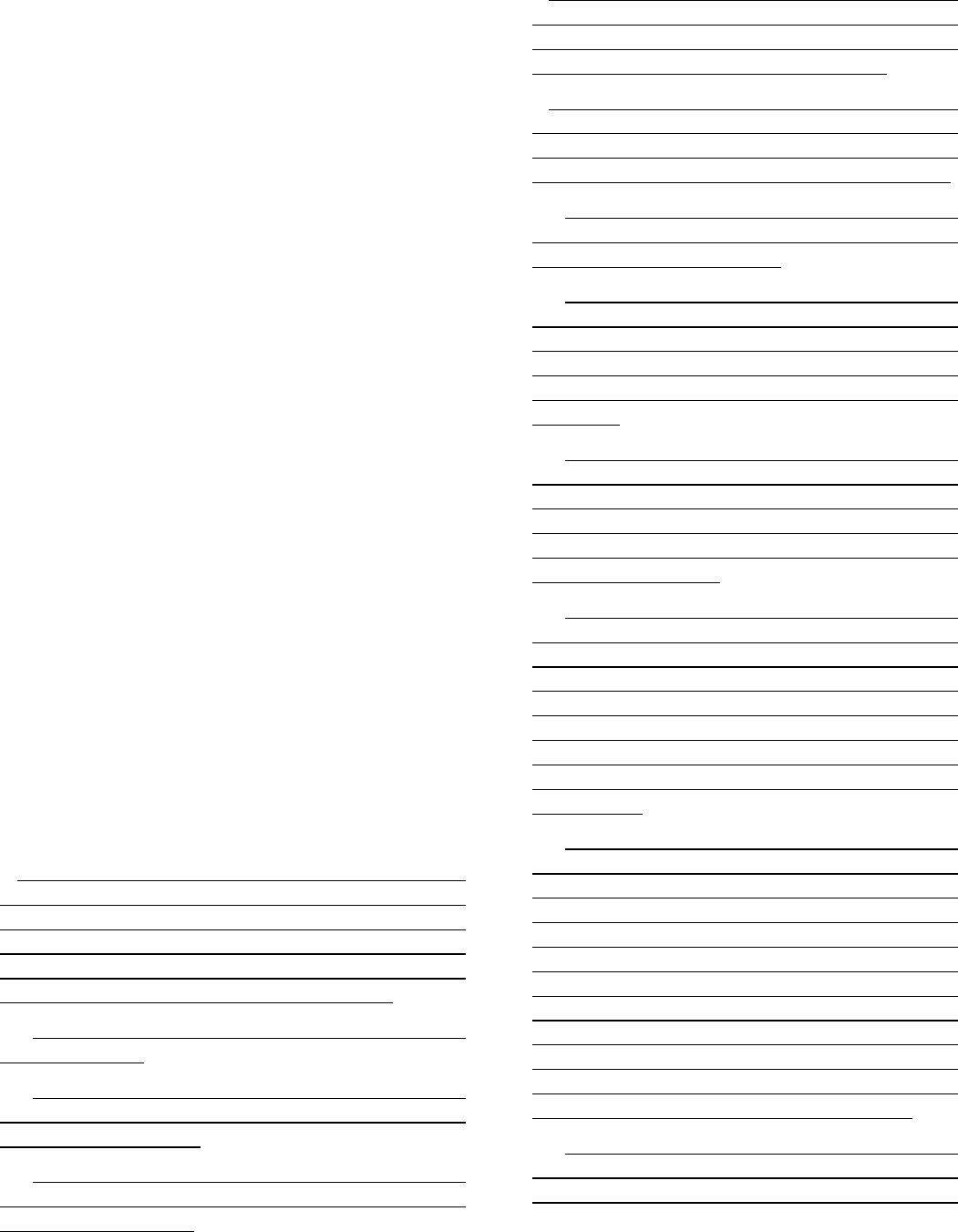
tank cannot be depended upon to remove disease
germs. The discharge of the effluent from septic tanks
into street gutters, surface ditches, or streams is
prohibited.
B. [Formerly paragraph A:2.2 of Appendix A] The
treatment level of a septic tank is referred to as primary
treatment.
C. [Formerly paragraph A:2.3 of Appendix A] The
preferred method of treatment for septic tank effluents
is accomplished through the use of soil absorption
trenches. Small oxidation ponds or sand filter beds may
be used in lieu of absorption trenches only where soil
and drainage conditions or available space prevent the
use of absorption trenches. The level of treatment of
these units is referred to as secondary treatment.
D. [Formerly paragraph A:2.4 of Appendix A] The use
of absorption trenches, oxidation ponds and filter beds
for the treatment of septic tank effluents is discussed in
detail in the following Paragraphs of these standards.
AUTHORITY NOTE: Promulgated in accordance with R.S. 40:4(A)(6)
and R.S. 40:5(9)(20).
HISTORICAL NOTE: Promulgated by the Department of Health and
Hospitals, Office of Public Health, LR 28:1349 (June 2002).
§719. Absorption Trenches
[formerly Section III of Appendix A]
A. [Formerly paragraph A:3.1 of Appendix A] Where
soil conditions are satisfactory and sufficient land is
available, septic tank effluent shall be disposed of in
absorption trenches. This consists of a system of covered
gravel (or other approved aggregate) filled trenches into
which the septic tank effluent is applied so as to permit
the liquid to seep into the soil. By action of
microorganisms in the soil, the organic matter is
converted into mineral compounds.
B. [Formerly paragraph A.3.2 of Appendix A] A
number of variables determine whether an absorption
trench is feasible, including: soil porosity (permeability),
ground water table, available space, and the rate at
which septic tank effluent enters the soil (percolation
rate). In general three conditions should be met.
1. The soil percolation rate must be within the
acceptable range.
2. The maximum elevation of the ground water
table should be at least 2 feet below the bottom of the
proposed trench system.
3. Clay formations or other impervious strata
should be at a depth greater than 4 feet below the
bottom of the trenches.
C. [Formerly paragraph A.3.3 of Appendix A]
Unless these conditions are satisfied, the site is
unsuitable for a subsurface sewage disposal system,
and an alternative method must be utilized.
D. [Formerly paragraph A.3.4 of Appendix A] The
acceptability of soil for an absorption trench system
and the required size of such a system is currently
based upon the "Percolation Test" described below.
1. Three or more tests must be made in
separate test holes spaced uniformly over the
proposed absorption field site.
2. Dig or bore a hole, with horizontal
dimensions of from 4 to 12 inches and vertical sides
to the depth of the proposed absorption trench. In
order to save time, labor, and volume of water
required per test, the holes may be bored with a 4-
inch auger.
3. Carefully scratch the bottom and sides of
the hole with a knife blade or sharp-pointed
instrument in order to remove any smeared soil
surfaces and to provide a natural soil interface into
which water may percolate. Remove all loose
material from the hole.
4. To conduct the test, fill the hole with clear
water. This pre-wetting procedure should normally
be accomplished on the day prior to the percolation
rate measurement. This procedure is to insure that
the soil is given ample opportunity to swell and to
approach the operating condition of the wet season
of the year. Thus, the test should give comparable
results in the same soil whether made in a dry or in
a wet season.
5. With the exception of sandy soils,
percolation rate measurements shall be made on
the day following the procedure described under
§719.D.4 above. Add water until the liquid depth is
at least 6 inches, but not more than 12 inches from
a fixed reference point. Measure the drop in water
level over a 60-minute period. This drop is used to
calculate the percolation rate. Section 1501.B.1
(Figure 1) shows methods of percolation rate
measurement. If the drop in liquid depth in the first
30 minutes is less than one inch, it is unnecessary to
continue the test for the full 60-minute period.
6. The distance the water falls in 60 minutes in
each of the three test holes is recorded. The average
drop for the three holes is used to determine the
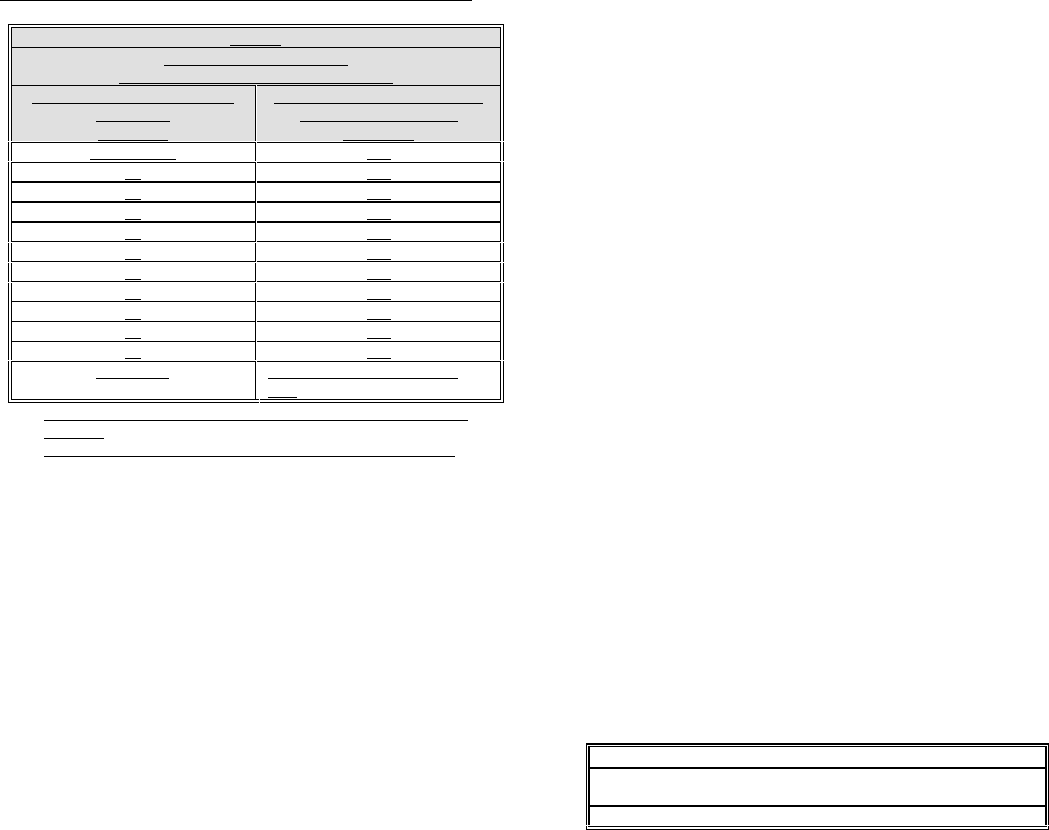
total length of absorption trench from Table 1 below.
Table 1
Absorption Trench Length
Requirements for Individual Residences
Average Water Level Drop in
60 minutes
(in inches)
Length (in Feet) of Absorption
Trenches Required per
Bedroom*
More than 12
72
12
83
11
87
10
91
9
96
8
100
7
104
6
110
5
117
4
127
3
142
Less than 3
Not acceptable for absorption
field
NOTE: A minimum of 160 linear feet of field line shall be
provided.
*-or per 150 gpd of design flow for non-residential applications.
E. [Formerly paragraph A:3.5 of Appendix A] Many
different designs may be used in laying out an absorption
trench system. The choice will depend on the size and
shape of the available disposal area, the capacity
required and the topography of the area.
F. [Formerly paragraph A:3.6 of Appendix A] The
septic tank effluent is applied to the absorption field
through a system of level bottomed trenches.
Conventional field lines are laid on a slope of 2 to 3
inches per 100 feet. Gravelless pipe and other
distribution chambers must be laid as close as possible to
a slope of 1 inch per 100 feet. A distribution box may be
required for equal distribution of the effluent. Section
1501.B.2 and 3 (Figure 2 and 3) show a typical layout of a
conventional absorption trench system for flat and
sloping areas.
G. [Formerly paragraph A:3.7 of Appendix A] To
provide the minimum required backfill depth and earth
cover, the depth of the absorption trenches must be a
minimum of 18 inches. Additional depth may be needed
for contour adjustment for extra backfill under the
distribution line or for other design purposes. However,
the total depth must not exceed 24 inches.
H. [Formerly paragraph A:3.8 of Appendix A] Careful
construction is important in obtaining a satisfactory soil
absorption system. Section 1501.B.4 (Figure 4) shows
details for absorption trench construction.
I. [Formerly paragraph A:3.9 of Appendix A]
Individual trenches shall not be greater than 100 feet in
length and not less than 18 inches in width. The center
line distance between individual trenches shall be at
least 6 feet. In addition, the absorption trenches
shall be located at least 10 feet from any dwelling or
property line.
J. [Formerly paragraph A:3.10 of Appendix A]
The location of the absorption trenches shall
comply with minimum distance requirements from
water wells, water lines, etc., as contained in Part XII
of this Code.
K. [Formerly paragraph A:3.11 of Appendix A] In
every case, at least two trenches shall be used.
L. [Formerly paragraph A:3.12 of Appendix A]
Trench bottoms must be level to promote even
distribution, thereby minimizing premature failure
of a portion of the trench. During excavation,
attention must be given to the protection of the
soil. Care must be taken to prevent sealing of the
surface on the bottom and sides of the trench.
Trenches should not be excavated when the soil is
wet enough to smear or compact easily. All smeared
or compacted surfaces must be raked to a depth of
1 inch and loose material removed before the
backfill is placed in the trench.
M. [Formerly paragraph A:3.13 of Appendix A]
Conventional field lines shall consist of perforated
non-metallic pipe meeting one of the following
standards.
PVC sewer pipe and fittings (Thin wall), ASTM D2729-93
Smooth wall polyethylene (PE) pipe, ASTM F810-93, for use in
waste disposal absorption fields;
SRP pipe and fittings, ASTM D2852-93.
1. In every case, the minimum acceptable
diameter is
4 inches. Although the trench bottom is level,
conventional field pipes must be laid on a slope of
between 2 to 3 inches per 100 feet to provide even
distribution of the liquid throughout the trench.
N. [Formerly paragraph A:3.14 of Appendix A]
Where conventional field pipe is used, it must be
surrounded by clean graded gravel or rock, broken,
hard-burned clay brick or similar material. The bed
material may range in size from
1/2 inch to 2.5 inches. The gravel must extend from
at least
2 inches above the top of the pipe to at least 6
inches below the bottom of the pipe. The top of the
stone should be covered with either untreated
building paper, or similar pervious material to
prevent the gravel from becoming clogged by the earth
backfill [see §1501.B.4 (Figure 4)].
O. [Formerly paragraph A:3.15 of Appendix A] Where
gravelless pipe or distribution chambers are used, the fill
must be porous soil or sand which allows the passage of
water in
all directions with a 6-inch layer below the pipe and filled
4 to 6 inches above grade and spread 3 to 4 feet on
either side of the trench. Only gravelless pipe or other
distribution chambers specifically approved for use in
Louisiana by the state health officer may be used. The
total length of gravelless distribution products required is
the same as for conventional absorption trenches.
P. [Formerly paragraph A:3.16 of Appendix A] For an
absorption trench to work properly, it must have access
to air, generally through the soil interstices of the
backfill. Therefore, the absorption trench should be
backfilled with 4 to 12 inches of pervious soil, hand-
tamped and then overfilled with about
4 to 6 inches of earth. Care should be taken to avoid
compacting of the backfill.
Q. [Formerly paragraph A:3.17 of Appendix A] All of
the above listed requirements, with the exception of the
protection of water supplies, are aimed at preventing
absorption trench clogging and premature failure. In
addition, the septic tank should be inspected every six
years after installation and pumped, as necessary, to
prevent solid overflow to the soil absorption system and
subsequent clogging and failure.
R. [Formerly paragraph A:3.18 of Appendix A]
Absorption trenches shall not be located:
1. beneath driveways, parking or other paved
areas;
2. in areas that may be subjected to passage or
parking of heavy equipment or vehicles, or storage of
materials;
3. beneath buildings or other structures.
AUTHORITY NOTE: Promulgated in accordance with R.S. 40:4(A)(6)
and R.S. 40:5(9)(20).
HISTORICAL NOTE: Promulgated by the Department of Health and
Hospitals, Office of Public Health, LR 28:1349 (June 2002).
§721. Oxidation Ponds
[formerly Section IV of Appendix A]
A. [Formerly paragraph A:4.1 of Appendix A] An
oxidation pond is a shallow pond designed specifically to
treat sewage by natural purification processes under the
influence of air and sunlight. The stabilization process
consists largely of the interactions of bacteria and algae.
Bacteria digest and oxidize the constituents of
sewage and render it harmless and odor free. Algae
utilize carbon dioxide and other substances
resulting from bacterial action and through
photosynthesis produce the oxygen needed to
sustain the bacteria in the treatment process.
During the detention period, the objectionable
characteristics of the sewage largely disappear.
B. [Formerly paragraph A:4.2 of Appendix A] The
minimum surface area of an oxidation pond must be
no less than 400 square feet with a 4 to 5 foot
average liquid depth and vertical side walls. This
minimum size pond is adequate for design flows of
up to 400 gallons/day (gpd). For design flows in
excess of 400 gpd, the pond area must be increased
to provide sufficient volume (at the 4 foot depth) to
hold 30 days worth of flow (a 30-day retention
period). For wastes with high BOD loadings, special
consideration for increasing pond size must be
given.
C. [Formerly paragraph A:4.3 of Appendix A]
Section 1501.B.5 (Figure 5) shows a typical layout
for a septic tank-oxidation pond system. The actual
layout of any pond system will be governed to a
great extent by the topography of the particular
location. However, an oxidation pond must be
located so as to comply with the minimum distance
requirements from water wells, lines, etc., as
contained in Part XII of this Code. It is also desirable
for aesthetic reasons to locate it as far as possible,
but at least 50 feet from any dwelling and no less
than 20 feet from the property line to water's edge
at normal operating line.
D. [Formerly paragraph A:4.4 of Appendix A] As
mentioned, the use of the minimum surface area of
400 square feet requires that an oxidation pond be
furnished with vertical side walls so that an
adequate volume for treatment is provided. Section
1501.B.6 (Figure 6) shows a type of construction
utilizing treated timber which under normal soil
conditions is acceptable for the vertical side walls of
a 20 foot by 20 foot oxidation pond with a 5 foot
average water depth. Section 1501.B.7 (Figure 7)
shows a similar type of construction utilizing
concrete blocks. Either of these designs requires
very little maintenance.
E. [Formerly paragraph A:4.5 of Appendix A]
Vertical side walls must be of cypress or treated
timbers or concrete blocks and so constructed as to
provide a permanent structure.
F. [Formerly paragraph A:4.6 of Appendix A]
Although not encouraged, a pond may be constructed
with sloping sides and earthen levees. Such a design is
shown in §1501.B.8 (Figure 8). The design requires a
minimum surface area of 625 square feet with a 5 foot
liquid depth at the center in order to achieve the
required volume. The cost of this design is less than that
of the vertical wall ponds referred to above, but more
space is needed and routine maintenance requirements
such as levee mowing are greater. The slope of the
natural earth side walls must not be shallower than one-
to-one (45-degree angle) [see §1501.B.8 (Figure 8)].
G. [Formerly paragraph A:4.7 of Appendix A] A septic
tank must precede the oxidation pond and must comply
with the septic tank requirements presented in these
regulations.
H. [Formerly paragraph A:4.8 of Appendix A] The pipe
from the septic tank to the pond as well as the outfall
pipe from the pond must be at least 4 inches in diameter
and placed at a minimum slope of 2 inches per 100 feet.
The inlet must extend 4 to 6 feet horizontally into the
pond and be directed downward at least 1 1/2 to 2 feet
below the liquid surface level. The outlet must extend 4
to 6 feet horizontally into the pond and consist of a tee
with the invert set at the operating water level of the
pond. One leg of tee must be open and extend above the
water level, while the down leg is extended 1 1/2 to 2
feet below the water level. The invert of the pond outlet
must be lower than the pond inlet invert [see §1501.B.8
(Figure 8)]. Additionally the invert of the pond inlet must
be at least 2 inches lower than the invert of the septic
tank outlet.
I. [Formerly paragraph A:4.9 of Appendix A] The
pond shall be enclosed by a suitable non-climbable fence
to keep out children, pets and livestock. An open type
fence (woven wire) is preferable because it will not
restrict sunlight and air which are necessary for the
treatment. The fence shall be at least
5 feet in height and be provided with a locked gate.
J. [Formerly paragraph A:4.10 of Appendix A]
Abandoned oxidation ponds (ponds no longer in active
use) shall be dewatered, allowed to dry and then filled
with soil to natural grade.
AUTHORITY NOTE: Promulgated in accordance with R.S. 40:4(A)(6)
and R.S. 40:5(9)(20).
HISTORICAL NOTE: Promulgated by the Department of Health and
Hospitals, Office of Public Health, LR 28:1351 (June 2002).
§723. Sand Filter
[formerly Section V of Appendix A]
A. [Formerly paragraph A:5.1 of Appendix A]
Another alternative for the secondary treatment of
septic tank effluent is a deep-type sand filter bed.
Treatment in a sand filter bed is accomplished by
the action of microorganisms in a sand bed in which
the suspended solids of the septic tank effluent
have been trapped by filtration. It is important that
the sand bed remain aerobic throughout the
treatment process. This is accomplished by exposing
the sand surface to the air as much as possible on a
continuous basis. Of course, the best way this can
be done is to place no cover whatsoever over the
sand bed. Since this is not aesthetically desirable for
homes, a coarse gravel cover of clean, washed
gravel, not to exceed 6 inches in depth over the bed
is permitted. No other cover is acceptable. A filter
bed system is shown in §1501.B.9 (Figure 9).
B. [Formerly paragraph A:5.2 of Appendix A] The
sand filter bed is constructed by placing perforated
pipe near the bottom of a rectangular area of the
required size in a layer of gravel covered by a layer
of coarse sand 24 inches deep. On top of this are
placed distribution lines (perforated pipe) likewise
encased in a layer of gravel [see §1501.B.10 (Figure
10)]. The septic tank effluent is distributed speedily
in the gravel cover spreading over the top of the
sand seeping slowly and vertically through the sand
to the bottom layer of gravel to be carried away in
the under drain line.
C. [Formerly paragraph A:5.3 of Appendix A]
Sand filter beds are to be constructed with a
minimum width of 12 feet and a minimum length of
25 feet. This minimum size filter bed is adequately
sized for design flows of up to 400 gpd. For greater
design flows, the required length shall be increased
by eight feet for each additional 150 gpd or portion
thereof.
D. [Formerly paragraph A:5.4 of Appendix A] The
bed must be drained completely. This may require
the bed to be raised above natural ground level.
E. [Formerly paragraph A:5.5 of Appendix A] To
prevent sand infiltration into the underdrain, a layer
of graded gravel must be placed over the
underdrain line and the entire bottom of the filter
bed. All gravel must be clean and washed.

F. [Formerly paragraph A:5.6 of Appendix A] Filter
sand shall conform to the following standard
specifications.
U.S.
Sieve Size
Tyler
Screen Size
% Passing
(By Weight)
Number 4
Number 4
95-100
Number 14
60-80
Number 16
Number 28
5-20
Number 50
Number 48
0-5
Number 100
Number 100
0
G. [Formerly paragraph A:5.7 of Appendix A] At least
two distribution lines must be provided and they must
be sloped 2 inches to 3 inches per 100 feet. The lines
must be 4-inch diameter, 20-inch long farm tile, 2 feet to
3-feet lengths of vitrified clay bell-and-spigot sewer pipe
laid with open joints, or perforated nonmetallic pipe
meeting one of the standards cited in §719.M. The ends
of the distribution lines must be half-closed [see
§1501.B.10 (Figure 10)].
H. [Formerly paragraph A:5.8 of Appendix A]
Underdrain pipe materials are the same as those for the
distribution pipe, however, the slope must be no less
than 4 inches per 100 feet.
I. [Formerly paragraph A:5.9 of Appendix A] The
filter bed must be appropriately protected from surface
runoff water.
J. [Formerly paragraph A:5.10 of Appendix A] The
filter bed must be located no less than 10 feet from the
property line.
K. [Formerly paragraph A:5.11 of Appendix A] The
location of the filter bed shall comply with minimum
distance requirements from water wells, water lines,
etc., as contained in Part XII of this Code.
AUTHORITY NOTE: Promulgated in accordance with R.S. 40:4(A)(6)
and R.S. 40:5(9)(20).
HISTORICAL NOTE: Promulgated by the Department of Health and
Hospitals, Office of Public Health, LR 28:1352 (June 2002).
*Editor's Note: The address cited in §725.G has changed to:
Department of Health and Hospitals
Office of Public Health
Engineering Services Section
P.O. Box 4489
Baton Rouge, LA 70821-4489
§725. Mechanical Waste Water Treatment Plants
[formerly Section VI of Appendix A]
A. [Formerly paragraph A:6.1 of Appendix A]
Mechanical wastewater treatment plants are small
plants capable of providing primary and secondary
treatment of sanitary sewage. All are considered to be
aerobic treatment units.
B. [Formerly paragraph A:6.2 of Appendix A] An
individual mechanical plant will be permitted where
individual sewerage systems would currently be
permitted under prevailing rules as set forth in this
Part of the state sanitary code. Sewage loading
criteria for determining the average daily design
flow and organic loading are contained in Chapter
15 of this Part.
C. [Formerly paragraph A:6.3 of Appendix A] An
individual mechanical plant will be permitted in lieu
of a conventional septic tank system (septic
tank/absorption field) only in accordance with the
provisions of §511.B of this Code, and where a
conventional septic tank system could not be
permitted.
D. [Formerly paragraph A:6.4 of Appendix A]
Permitted individual mechanical plants shall strictly
comply with National Sanitation Foundation
International Standard, NSF 40-1996 for Residential
Wastewater Treatment Systems (Class I Systems) as
revised May 1996 and published by NSF
International, P.O. Box 130140, Ann Arbor, Michigan
48113-0140 USA, and as has been approved by the
American National Standards Institute, 11 West
42nd Street, New York, New York 10036 as standard
ANSI/NSF 40-1996, revised May 28, 1996.
E. [Formerly paragraph A:6.5 of Appendix A] All
individual mechanical plants currently approved for
installation in Louisiana as of the effective date of
these regulations shall not be required to meet the
requirements of §725.D until March 1, 2001. Until
March 1, 2001, plants shall continue to comply with
the standards under which they were approved.
Effective March 1, 2001, all plants shall comply with
the standard as stated in §725.D.
F. [Formerly paragraph A:6.6 of Appendix A] In
addition to evidence of strict compliance with NSF
International Standard NSF 40-1996 (Class I
Systems), and ANSI/NSF 40-1996 (Class I Systems),
as are specified in §725.D of this Code, the following
Department of Health and Hospitals/Office of Public
Health (DHH/OPH) requirements shall also apply.
1. Testing/Evaluation (General)
a. All certifications of individual mechanical
plants shall be conducted by an American National
Standards Institute (ANSI) accredited certification
program testing/evaluation facility authorized for
such purpose(s). Verification of such certification
shall be provided to DHH/OPH, subject to
acceptance by DHH/OPH of such verification, as
prerequisite to consideration of any individual
mechanical (residential) plant for permitting in Louisiana.
b. Evidence of acceptance by DHH/OPH of an
ANSI accredited testing/evaluation facility, for purpose of
testing/evaluation of individual mechanical (residential)
plant(s) for permitting in Louisiana shall be
demonstrated upon execution of an appropriate
Memorandum of Understanding (MOU), or other, similar
contractual instrument, subject to terms and conditions
as may be imposed by DHH/OPH―said MOU to be
between DHH/OPH and the testing/evaluation facility.
c. Successful completion of testing/evaluation of
an individual mechanical (residential) plant in
accordance with applicable provisions of this Code,
having been properly tested/evaluated and certified by
an appropriate facility, shall serve to allow the DHH/OPH
authorization of an individual mechanical (residential)
plant for permitting purposes in Louisiana for a period
not to exceed seven years from the date of such
DHH/OPH authorization, or until such time as an
appropriate revision to the prevailing testing/evaluation
standard for such purposes may become revised. Such
authorization of an individual mechanical (residential)
plant for permitting purposes in Louisiana shall be in the
form of a written license by DHH/OPH to a manufacturer
of such individual mechanical (residential) plant(s),
subject to compliance with applicable provisions of this
Code―such license to be valid for the specified period,
annually renewable, and suspendable/revocable by
DHH/OPH in accordance with license revocation
procedures as specified in §735.F.
2. Licensing
a. In addition to evidence of compliance of an
individual mechanical (residential) plant having been
properly tested/evaluated and certified by an
appropriate facility, certain additional requirements shall
serve as a basis for licensing by DHH/OPH of such
individual mechanical (residential) plant in Louisiana.
These additional requirements shall apply, as
appropriate, to the manufacturer and/or manufacturer
representative, agent, sub-manufacturer or other
associated entity, as appropriate, involved in the
manufacture, marketing, sale, installation and/or
maintenance of such (any) individual mechanical
(residential) plant(s) in Louisiana. Further, with respect to
the testing/evaluation facility which may have certified
the individual mechanical plants being in compliance
with the testing/evaluation standard contained herein,
certain additional requirements, for licensing
purposes, shall apply.
b. These additional requirements are
specified as follows.
i. Testing/Evaluation Facility
Responsibilities
(a). In addition to providing
testing/evaluation services with respect to
individual mechanical (residential) plants scheduled
for manufacture, marketing, sale, installation and
maintenance in Louisiana, the testing/evaluation
facility shall also serve to provide oversight liaison
services both to the manufacturer of the individual
mechanical (residential) plant, as well as to DHH/
OPH. However, DHH/OPH communication with the
testing facility will be at the OPH Program Manager
level, or higher. While it is recognized that the
testing/evaluation facility may exercise its fiduciary
right to exact such fees or other reimbursement
costs as appropriate from a manufacturer (client),
under no circumstances may the testing/evaluation
facility exact such fees or other reimbursement
costs from DHH/OPH in order to compensate for
any of these regulatory requirements. Accordingly,
the following requirements shall be included in the
MOU.
(b). It shall be required that all individual
mechanical (residential) plant manufacturers will be
inspected annually by the testing/evaluation facility
having certified the related individual mechanical
(residential) plant and that DHH/OPH shall be, upon
request, furnished with copies of all reports of such
inspections, which shall include at a minimum the
verification (or reverification) of all "forms" used in
the manufacture (or sub-manufacture) of individual
mechanical (residential) plants.
(c). It shall be required that a
representative number, up to 4 but in, no case more
than 10 percent, of all manufacturers authorized
sub-manufacturers of individual mechanical
(residential) plants will be inspected annually by the
testing/evaluation facility having certified the
related individual mechanical (residential) plant and
that a report shall be retained by the
testing/evaluation facility and shall, upon request by
DHH/OPH, make such information available to
DHH/OPH, which shall include at a minimum the
verification of service records for all related
individual mechanical (residential) plant installations and
availability of stand-by parts.
(d). It shall be required that a representative
number of installations in Louisiana, but in no case less
than 10, of all individual mechanical (residential) plants
manufactured by manufacturers and their respective
sub-manufacturers will be inspected annually by the
testing/evaluation facility having certified the related
individual mechanical (residential) plant and that a
report shall be retained by the testing/evaluation facility
and shall, upon request by DHH/OPH, make such
information available to DHH/OPH, which shall include at
a minimum the verification (or re-verification) that
individual mechanical (residential) plants and their
respective installation(s) are in conformity with the plans
and specifications as are reflected in the
testing/evaluation report which was approved for the
related individual mechanical (residential) plant.
(e). It shall be required that copies of all
inspection/audit reports conducted by a
testing/evaluation facility with regard to a client-related
manufacturer (or sub-manufacturer) of individual
mechanical (residential) plants will be retained by the
testing/evaluation facility and shall, upon request by
DHH/OPH, make such information available to DHH/OPH
upon completion of said report(s).
(f). It shall be required that copies of all
reports of non-compliance and/or reports of
complaint(s) investigations by a testing/ evaluation
facility with respect to a client-related manufacturer (or
sub-manufacturer) of individual mechanical (residential)
plant(s) will be retained by the testing/evaluation facility
and shall, upon request by DHH/OPH, make such
information available to DHH/OPH upon completion of
said report(s).
(g). It shall be required that any
modification(s) to an individual mechanical (residential)
plant, once certified by an ANSI accredited
testing/evaluation facility, shall be subject to re-
evaluation by the testing/evaluation facility and that
written acceptance of the change by the ANSI accredited
testing/evaluation facility shall be received by the
manufacturer prior to incorporating the change; this
information also to be transmitted to DHH/OPH.
(h). In the event that the original
testing/evaluation facility no longer conducts
testings/evaluations and certifications of individual
mechanical (residential) plants for a specific
manufacturer, it will be the responsibility of the
testing/evaluation facility to insure an orderly
transfer of the documentation supporting
certification to the manufacturer for transmittal to
another ANSI accredited testing/evaluation facility
at the manufacturers choice.
ii. Manufacturer/Sub-Manufacturer
Responsibilities
(a). In addition to other, related
requirements of this code as pertain to the
manufacture, marketing, sale, installation and
maintenance of individual mechanical (residential)
plant(s) in Louisiana, the manufacturer (or sub-
manufacturer, or installer, as appropriate) of an
individual mechanical plant shall also be responsible
for insuring compliance with the following.
(b). It shall be required that the
manufacturer/sub-manufacturer shall annually
inspect at least 10 percent of its authorized
installers in Louisiana of certified individual
mechanical (residential) plants (products) and shall
provide written reports of such inspections, which
shall minimally address certain matters specified by
DHH/OPH, both to the testing/evaluation facility of
record as well as to DHH/OPH.
(c). It shall be required that the
manufacturer/sub-manufacturer(s) installers of
individual mechanical (residential) plant(s) must
maintain a current list of all sales/installations of
individual mechanical (residential) plants and shall,
upon request by DHH/OPH, make such information
(i.e., name, address of purchaser, date of sale, etc.)
available to DHH/OPH.
(d). It shall be required that
manufacturers/sub-manufacturers/installers, as
appropriate must provide a minimum two-year
service policy to the purchaser of each individual
mechanical (residential) plant purchased/ installed
at no additional cost, with verification provided to
DHH/OPH and the purchaser, of such service policy
provision. The initial policy shall contain provisions
for four inspection/service visits (scheduled once
every six months over the two-year period) during
which electrical, mechanical, and other applicable
components are inspected, adjusted, and serviced.
The initial service policy shall also contain provisions
for an effluent quality inspection consisting of a
visual assessment of color, turbidity, and scum
overflow, and an olfactory assessment for odor.
(e). It shall be required that the
manufacturers/sub-manufacturers/installers, as
appropriate must make available (subject to the
purchaser's right of refusal) an extended
service/maintenance agreement with terms comparable
to those in the initial service policy, in writing.
(f). The manufacturer/sub-manufacturer shall
insure that the individual mechanical (residential) plant
and its component parts are properly and easily
identified.
(g). The manufacturer/sub-manufacturer shall
secure such license(s) as may be required by other,
applicable provisions of this code for purpose(s) of
manufacture, marketing, sale, installation and/or
maintenance of individual mechanical (residential)
plant(s) in Louisiana―such license(s) requirement(s) to
include, at a minimum as condition of licensure, the
verifiable imposition of such insurance, bonding and
related requirements as may become stipulated by
DHH/OPH for purpose(s) of such related business
activities conducted in Louisiana.
(h). Manufacturers shall specifically authorize
the ANSI accredited testing/evaluation facility to release
to DHH/OPH all of the documentation outlined in terms
Subclauses i.(a)-(h) above.
3. Certification
a. Licensing will be based on a two phase
certification process, as follows.
i. Initial Certification. Consisting of evidence of
successful completion of the herein prescribed testing of
an individual mechanical (residential) plant, by the
appropriate ANSI accredited testing/evaluation facility
conjunctive with an actual onsite physical inspection and
audit of all plant manufacturer (company) and sub-
manufacturer facilities and production locations by the
appropriate ANSI accredited testing facility.
ii. Continuing Certification. Consisting of
evidence of an annual re-certification, re-inspection and
re-audit by the ANSI accredited testing/evaluation facility
of all plant manufacturers (company) and sub-
manufacturer facilities and production locations, as well
as an evaluation of a representative number (no less
than four) of all manufacturers authorized distributors
and plants (units/models) sold and installed, with
report(s) of such evidence available to DHH/OPH upon
request.
G. [Formerly paragraph A:6.7 of Appendix A] Persons
proposing to sell individual mechanical plants for
installation in Louisiana shall submit an evaluation report
indicating compliance with ANSI/NSF Standard
Number 40 and obtain approval from the
*Department of Health and Hospitals, Office of
Public Health, P.O. Box 60630, New Orleans, LA
70160, prior to selling/installing plants in the state.
The compliance evaluation report shall be prepared
by an ANSI certified testing laboratory as required in
§725.F, and shall include positive identification of all
owners, officers, agents, stockholders, contractors,
sub-contractors, as may be in any manner or by any
means associated with the entity seeking a permit.
1. [Formerly paragraph A.6.7-1 of Appendix A]
Upon approval of an evaluation report by the
Department of Health and Hospitals, Office of Public
Health, the subject individual mechanical plant may
be permitted for use in Louisiana. The Office of
Public Health will maintain a list of licensed
Manufacturers and respective individual mechanical
plants permitted for sale/installation in the state.
2. [Formerly paragraph A:6.7-2 of Appendix A]
Any alteration or modification of an individual
mechanical plant without the certification of the
ANSI certified testing laboratory and subsequent
approval of DHH-OPH shall constitute a violation of
this Section and shall be grounds for
suspension/revocation of any permit or license held
by each person responsible for such changes,
alterations or modifications.
H. [Formerly paragraph A:6.8 of Appendix A]
Licenses shall remain valid subject to the following.
1. No person involved with the testing facility
either directly or indirectly, may become an owner,
partner, or stockholder of any company holding any
license to manufacture, submanufacture, install or
maintain individual mechanical treatment plants in
Louisiana within two years of the approval date of
said plant by the Office of Public Health.
2. Should a change of ownership occur, the
manufacturer license for such plant shall be
rescinded.
3. The licensed Manufacturer shall submit to
the Office of Public Health, not later than January
31 of each year, proof that they have secured
general liability insurance in an amount of not less
than $1,000,000.
4. The licensed Manufacturer shall be
responsible for assuring that their mechanical plants
are sold only to licensed submanufacturers and
installers in order to prevent the installation of their
plants by unauthorized persons.
I. [Formerly paragraph A:6.8-1 of Appendix A]
Persons appealing the denial of their application under
the Administrative Procedure Act shall post a cost bond
prior to the scheduling of such hearing. The plaintiff shall
forfeit the cost bond to the state when said appeal is
denied by the hearing officer. The hearing officer is to
determine the amount of the cost bond, on a per diem
basis. The costs shall include room rental, hearing officer
fees, court reporter fees, and transcript costs.
J. [Formerly paragraph A:6.9 of Appendix A]
Individual mechanical plants and all components must be
installed in compliance with the minimum separation
requirements for water wells and appurtenances as
required in Part XII of this Code.
K. [Formerly paragraph A:6.9-1 of Appendix A]
Individual mechanical plants should be installed at least
10 feet from the property line.
L. [Formerly paragraph A:6.10 of Appendix A]
Determination of compliance with NSF Standard Number
40 requirements and/or additional related requirements
provided for in this Subchapter shall be the responsibility
and sole authority of the state health officer acting
through the Office of Public Health.
M. [Formerly Part B paragraph A:6.11 of Appendix A]
Warranty/Maintenance/Service Provisions
1. The "Individual Mechanical Plant Initial Warranty
Inspection/Service Report" must be submitted to the
state health officer after each warranty/maintenance
inspection is completed by the maintenance provider,
and will become part of the permanent record for each
system. A maintenance contract shall be offered to the
owner after the initial two-year service contract expires
in accordance with National Sanitation Foundation
Standard Number 40 relating to Residential Wastewater
Treatment Systems, adopted by the Board of Trustees of
the National Sanitation Foundation (NSF), Ann Arbor,
Michigan, as revised May 1996. The maintenance
provider shall notify the state health officer whenever an
extended service contract has been negotiated.
2. [Formerly paragraph A:6.12 of Appendix A] The
owner is responsible for perpetual maintenance of the
sewerage system and components thereof. Proof of
perpetual maintenance of the system shall be provided
in the form of an extended service contract.
AUTHORITY NOTE: Promulgated in accordance with R.S. 40:4(A)(6)
and R.S. 40:5(9)(20).
HISTORICAL NOTE: Promulgated by the Department of
Health and Hospitals, Office of Public Health, LR 28:1352 (June
2002).
*Editor's Note: The address cited in §727.C has changed to:
Department of Health and Hospitals
Office of Public Health
Engineering Services Section
P.O. Box 4489
Baton Rouge, LA 70821-4489
§727. Sanitary Pit Privy
[formerly Section VII of Appendix A]
A. [Formerly paragraph A:7.1 of Appendix A]
Where a dwelling is not served with water under
pressure, water carriage waste systems as covered
herein can not be used. In these cases, a pit privy or
other non water-borne system is required for
excreta disposal.
B. [Formerly paragraph A:7.2 of Appendix A] Pit
privies, when used, shall be located so that they will
not pollute domestic, private, or public water
supplies. To accomplish this, they must be located
on the downgrade from water wells and water
supply lines and in accordance with the minimum
distance requirements as contained in Part XII of
this Code. Pit privies must be located at least four
feet from any fence, ditch or building to give room
for a proper earth mound. They must be housed as
separate units and must be located at least 10 feet
from the property line.
C. [Formerly paragraph A:7.3 of Appendix A]
Details of the construction and maintenance of
approved pit privies may be obtained by referring to
a pamphlet entitled "Louisiana Type Sanitary Pit
Privy" which is available through the *Department
of Health and Hospitals, Office of Public Health, P.O.
Box 60630, New Orleans, LA 70160.
AUTHORITY NOTE: Promulgated in accordance with R.S.
40:4(A)(6) and R.S. 40:5(9)(20).
HISTORICAL NOTE: Promulgated by the Department of
Health and Hospitals, Office of Public Health, LR 28:1355 (June
2002).
§729. Pumping Stations
[formerly Section VIII of Appendix A]
A. [Formerly paragraph A:8.1 of Appendix A]
When the elevation of a site prevents the use of
gravity flow to convey liquid from one location to
another, a pumping station [§1501.B.19 (Figure 22)],
consisting of a holding tank, pump(s), piping,
electrical controls, and other equipment as
necessary, must be provided.
B. [Formerly paragraph A:8.2 of Appendix A] Many
manufacturers build pumps, and in some cases complete
pump stations, for the special purpose of handling
wastewater, either raw, partially treated, or treated. Such
specially built pump stations may be used, provided all
other code requirements are met.
C. [Formerly paragraph A:8.3 of Appendix A] Pumps
utilized in pump stations must be suitable for the specific
application proposed. Pumps must be provided with
impellers and casings constructed of corrosion resistant
materials.
D. [Formerly paragraph A:8.4 of Appendix A] Pumps
shall be provided to accommodate required elevation
and hydraulic heads and peak flow rates, and be cycled
in a manner not to be unduly disruptive to any
downstream system.
E. [Formerly paragraph A:8.5 of Appendix A] The
pump station holding tank must be constructed of
materials suitable for septic tank use in accordance with
§715.I and O of this Subchapter. Additionally, molded
fiberglass, reinforced polyester (FRP) resin tanks having a
minimum wall thickness of 1/4" are also acceptable.
F. [Formerly paragraph A:8.6 of Appendix A] Holding
tanks shall be constructed and installed with suitable
foundations to prevent settling due to soil conditions or
floating of the tank due to high water table elevations.
G. [Formerly paragraph A:8.7 of Appendix A] Pump
station holding tanks shall be constructed and installed
so as to be watertight. All wall seams, seams between
walls and tank floor, and openings such as for pipes and
wiring shall be sealed watertight. Additionally, all holding
tank covers and access openings shall be attached in
watertight manner by gaskets or grooves and should be
sufficiently above the ground, but in no case less than 3
inches above ground, to prevent the entrance of surface
runoff water.
H. [Formerly paragraph A:8.8 of Appendix A] The
holding tank shall have a minimum diameter or
dimension of 24 inches. The cover shall be equipped
with an access opening of sufficient size to allow for
pump maintenance and removal, but in no case less than
12 inches in diameter or dimension.
I. [Formerly paragraph A:8.9 of Appendix A] Pumps
shall be installed in such a manner as to allow for
removal and/or maintenance of the pump without
necessitating entry into the holding tank by maintenance
personnel. Pumps shall be provided with suitable means
of quick, convenient disconnection from discharge piping
and electrical wiring. Provisions must be made for lifting
the pump from the holding tank with minimal
exposure to the liquid in the tank.
J. [Formerly paragraph A:8.10 of Appendix A]
Suitable level control devices for use in the harsh,
corrosive environment encountered, shall be
provided to control pump operation. The level
controls shall provide for the following functions:
"pump off," "pump on," and "high water alarm."
1. [Formerly paragraph A:8.10-2 of Appendix
A] All materials utilized within the holding tank,
whether above or below water level, shall be
constructed of materials resistant to corrosion from
the hostile operating environment of the tank.
2. [Formerly paragraph A:8.10-3 of Appendix
A] An audible and visual "high water alarm" shall be
provided and shall be located in a conspicuous
location. A reset button should be provided for the
audible signal in a convenient location so that relief
can be easily obtained.
3. [Formerly paragraph A:8.10-4 of Appendix
A] The "pump off" level shall be set at the minimum
elevation as recommended by the specific pump's
manufacturer.
4. [Formerly paragraph A:8.10-5 of Appendix
A] The "pump on" level shall be set at elevation to
provide a minimum working volume of 10 percent
of the average daily design flow of the treatment
system.
5. [Formerly paragraph A:8.10-6 of Appendix
A] The "high water alarm" level shall be set so as to
provide for a net storage volume between the
"pump on" level and the "high water alarm level" of
10 percent of the average daily design flow of the
treatment system.
6. [Formerly paragraph A:8.10-7 of Appendix
A] A reserve volume may be provided between the
"high water level" and the invert of the inlet pipe to
the holding tank, if so desired.
K. [Formerly paragraph A:8.11-1 of Appendix A]
All electrical wiring and controls must be
appropriate for the applications for which they are
used and meet prevailing electrical codes. Due
consideration for the exposure to a harsh
environment and the need for watertight
connections and conduit must be accounted for in
all electrical work.
1. [Formerly paragraph A:8.11-2 of Appendix
A] Electrical connections to the main panel in the

house must be made according to prevailing electrical
codes.
2. [Formerly paragraph A:8.11-3 of Appendix A] The
pump must be wired for automatic level control with a
manual override located at the control panel.
L. [Formerly paragraph A:8.12 of Appendix A] Raw
sewage pumps and piping must accommodate the
passage of
2-inch solids.
M. [Formerly paragraph A:8.13 of Appendix A] Suction
and discharge piping for sewage effluent pumps must
conform to the pump manufacturer's recommendations.
However, piping should not be less than 1.25 inches in
diameter and be capable of withstanding a pressure of
75 psi.
AUTHORITY NOTE: Promulgated in accordance with R.S. 40:4(A)(6)
and R.S. 40:5(9)(20).
HISTORICAL NOTE: Promulgated by the Department of Health and
Hospitals, Office of Public Health, LR 28:1355 (June 2002).
§731. Effluent Reduction System Requirements
for Treated Wastewater
[formerly Section IX of Appendix A]
A. [Formerly paragraph A:9.1 of Appendix A]
Disinfectants. Where effluent discharges are required to
be disinfected, and chlorine is used as the disinfectant, a
chlorine contact chamber is required. Calcium
hypochlorite, labeled for wastewater disinfection, shall
be added in sufficient concentrations to maintain a
minimum residual of 0.5 ppm total chlorine in the
effluent. In order to achieve the required chlorine
contact time, a baffled chlorine contact chamber
[§1501.B.11 (Figures 11, 12, 13)] designed to meet the
needs for each system with the specified liquid holding
capacity shall be used as follows.
Disinfectant Chamber Minimum Liquid Capacity
Treatment Capacity of
Sewerage System
Contact Chamber
Liquid Capacity
500 GPD or less
30 gallons
501-750 GPD
45 gallons
751-1000 GPD
60 gallons
1001-1500 GPD
90 gallons
1. Any other disinfectant proposed for use should
provide an equivalent level of disinfection.
B. [Formerly paragraph A:9.2 of Appendix A] Pumping
Stations. Pumping station, when required, must be
constructed of approved materials, and must comply
with the applicable provisions of this Code.
C. [Formerly paragraph A:9.3 of Appendix A] Effluent
Reduction Systems. Individual sewage systems, with a
capacity up to and including 1500 gpd, that produce
a treated, off-site effluent, shall include an effluent
reducer as part of the overall system [§1501.B.12
(Figure 14)].
D. [Formerly paragraph A:9.4 of Appendix A]
Special situations may arise where an individual on-
site wastewater treatment system is allowed as per
§511.B of this Code, but it is physically impossible to
install the required size of the effluent reduction
system or the effluent reduction system itself due to
lot size or when a limited use sewerage system is
installed in a marsh/swamp area or located over
water. The size of the effluent reduction system can
be reduced to the maximum amount the lot can
accommodate or the installation waived with the
authorization of the sanitarian parish manager.
Written notification of such authorization must be
submitted to the sanitarian regional director and a
copy attached to the "Application for Permit for
Installation of On-Site Wastewater Disposal System"
(LHS-47).
E. [Formerly paragraph A:9.5 of Appendix A] All
effluent reduction systems shall be installed by a
licensed installer. Existing field lines can not be used
as the effluent reduction system.
F. [Formerly paragraph A:9.6 of Appendix A] The
size of the effluent reduction system installed has to
correspond with the recommended size of the
sewerage system. For example if a 750 GPD plant is
required on the "Application For Permit For
Installation of On-Site Wastewater Disposal System"
(LHS-47), the applicant may install a 1000 GPD
plant, however the size of the effluent reduction
system only has to correspond to the minimum size
required for a 750 GPD plant.
G. [Formerly paragraph A:9.7 of Appendix A] The
sample port for a sewerage system must be installed
immediately downstream of the system and in
accordance with the appropriate edition and
Section of NSF Standard 40, as currently
promulgated, as well as the applicable provisions of
this Code.
AUTHORITY NOTE: Promulgated in accordance with R.S.
40:4(A)(6), R.S. 40:5(9)(20), and R.S. 40:1154(A).
HISTORICAL NOTE: Promulgated by the Department of
Health and Hospitals, Office of Public Health, LR 28:1356 (June
2002).
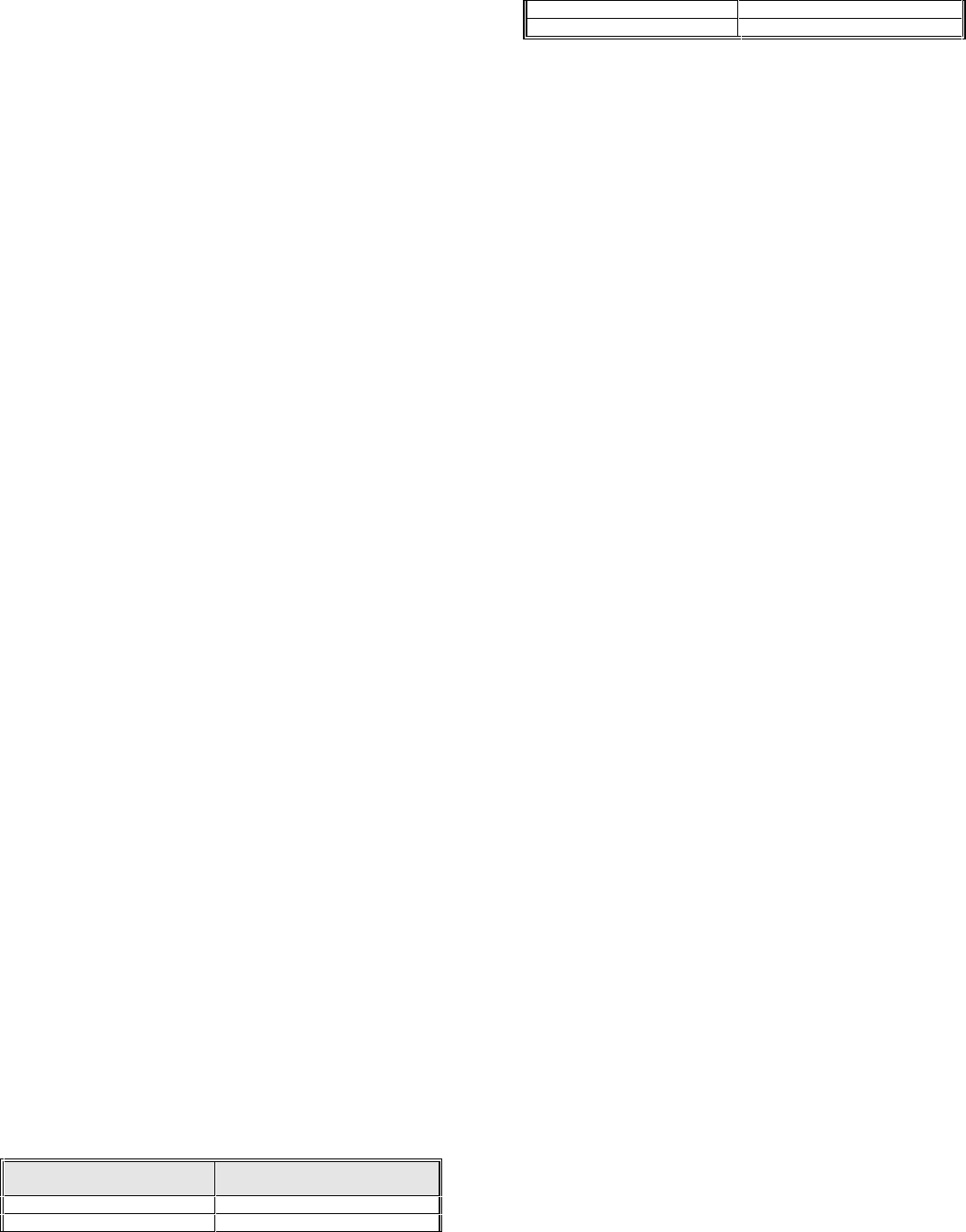
§733. Effluent Reduction Options
[formerly Section IX of Appendix A]
A. [Formerly paragraph A:9.8-1 of Appendix A]
Effluent Reduction Field. This system is installed
downstream of a mechanical treatment plant or other
sewage treatment system listed in Chapter 7 Subchapter
B of this Code that produces an effluent, but does not by
design significantly reduce that effluent. The effluent
reduction field is essentially a soil absorption field as
described in §719 of this Subchapter, but with
modification as noted in this Section. Section 1501.B.13
(Figure 15) has a diagram with specifications and cross-
sections of the effluent reduction field.
1. [Formerly paragraph A:9.8-2 of Appendix A] If
there is not sufficient grade to install the sewerage
system and the effluent reduction field with gravity flow
to the discharge point, then a pump station in
compliance with applicable provision of this code must
be installed.
2. [Formerly paragraph A:9.8-3 of Appendix A] The
force of the pumped effluent must be reduced by use of
a distribution box, "Tee," or similar appurtenance.
3. [Formerly paragraph A:9.8-4 of Appendix A] The
effluent reduction field trenches shall be at least 18
inches wide and between 16 to 24 inches in depth.
4. [Formerly paragraph A:9.8-5 of Appendix A] The
bottom of the effluent reduction field must be level.
5. [Formerly paragraph A:9.8-6 of Appendix A] The
fill or cover material shall be of porous soil or sand which
allows the passage of water in all directions, with sod
started on top. Fill should be at least 4 to 6 inches above
grade and spread at least 3 to 4 feet on either side of the
trench.
6. [Formerly paragraph A:9.8-7 of Appendix A] The
effluent reduction field (ERF) must be installed a
minimum of 10 feet from any property line. In addition
the ERF field location shall comply with the minimum
distance requirements from water wells and suction
lines, water pressure lines, etc., as contained in Parts XII
and XIV of this Code.
7. [Formerly paragraph A:9.8-8 of Appendix A] The
minimum length of the effluent reduction field shall be
determined by the treatment capacity of the sewerage
system.
Treatment Capacity of
Sewerage System
Minimum Total Length
per Field
500 GPD or less
100 ft
501-750 GPD
150 ft
751-1000 GPD
200 ft
1001-1500 GPD
300 ft
8. [Formerly paragraph A:9.8-9 of Appendix A]
If more than one absorption trench is used to
provide the minimum required length of the
effluent reduction field, the distance between
individual trenches must be at least 6 feet with one
discharge pipe provided.
9. [Formerly paragraph A:9.8-10 of Appendix
A] The pipe from the end of the effluent reduction
field to the discharge point must be solid.
10. [Formerly paragraph A:9.8-11 of Appendix
A] A backwater valve must be provided at the end of
the effluent reduction field whenever the discharge
line is less than
12 inches above the ditch flow-line.
11. [Formerly paragraph A:9.8-12 of Appendix
A] Each individual trench must not be greater than
100 feet in length. Clam or oyster shells may be
substituted for gravel in the effluent reduction field.
If used, gravel must be clean, graded and 1/2-inch
to 2 1/2 inches in diameter. Other media may be
considered for use if determined to have acceptable
characteristics and properties. Although it may not
be noted in the attached figures (§1501.B.1-19), the
end of the discharge line must have a 1/2 diameter
PVC end cap over the lower half of the endpipe,
causing longer retention of the effluent and
providing greater opportunity for absorption. If the
end of the discharge line is more than 2 inches
lower than the absorption line, other provisions
must be made to cause the effluent to be retained
in the reduction field.
12. [Formerly paragraph A:9.8-13 of Appendix
A] Gravelless pipe or other distribution chambers
may be used in lieu of conventional soil absorption
pipe. If gravelless pipe is used, the fill must be
porous soil or sand which allows the passage of
water in all directions, with a 6-inch layer below the
pipe and filled 4 to 6 inches above grade and spread
3 to 4 feet on either side of the trench.
B. [Formerly A:9.9-1 of Appendix A] Rock-Plant
Filter. All rock plant filters must be a minimum of 5
feet wide to a maximum of 10 feet wide.
1. [Formerly paragraph A:9.9-2 of Appendix A]
The square footage will be determined by the
treatment capacity of the sewerage system as
follows.

Treatment Capacity
of Sewerage System
Rock Plant Filter Size
500 GPD or less
150 square feet
501-750 GPD
225 square feet
751-1000 GPD
300 square feet
1001-1500 GPD
450 square feet
a. Refer to §1501.B.14 (Figures 16 and 17) for a
schematic and cross section of a rock plant filter with a
sewerage system installation.
2. [Formerly paragraph A:9.9-3 of Appendix A] The
rock plant filter (RPF) must be installed a minimum of 10
feet from any property line. In addition, the RPF location
shall comply with the minimum distance requirements
from water wells and suction lines, water pressure lines,
etc., as contained in Parts XII and XIV of this Code.
3. [Formerly paragraph A:9.9-4 of Appendix A] If
there is not sufficient grade to install the sewerage
system and the rock plant filter with gravity flow to the
discharge point, then a pumping station in compliance
with applicable provisions of this Part must be installed.
4. [Formerly paragraph A:9.9-5 of Appendix A] In
order to prevent backflow, a backwater valve is required
whenever the discharge line is less than 12 inches above
the ditch flow-line.
5. [Formerly paragraph A:9.9-6 of Appendix A] Only
a standard shape bed may be installed with a minimum
width of 5 feet and of such length as to provide the
required square footage.
6. [Formerly paragraph A:9.9-7 of Appendix A]
Plans for any other configuration must be submitted for
review and approval to the sanitarian regional director.
7. [Formerly paragraph A:9.9-8 of Appendix A] A
liner will be required when the ground water level is
within 24 inches of the bottom of the trench.
8. [Formerly paragraph A:9.9-9 of Appendix A] The
polyethylene liner may be of more than one layer
provided a total thickness of 16 mil is achieved.
9. [Formerly paragraph A:9.9-10 of Appendix A]
When a liner is not required, the use of landscape fabric
is highly recommended to prevent weed intrusion.
10. [Formerly paragraph A:9.9-11 of Appendix A] The
bottom of the bed must be level and be no deeper than
14 inches.
11. [Formerly paragraph A:9.9-12 of Appendix A] A
depth of approximately 10 to 12 inches is best.
12. [Formerly paragraph A:9.9-13 of Appendix
A] Gravel must be 2-3 inches in diameter and laid to
a depth of 12 inches.
13. [Formerly paragraph A:9.9-14 of Appendix
A] An
8-inch water level must be maintained. Gravel
should fill the filter bed to above surface grade to
prevent erosion.
14. [Formerly paragraph A:9.9-15 of Appendix
A] The minimum 4-inch perforated inlet pipe must
be located no closer than 4 inches from the bottom
of the bed and supported by a footing of
noncorrosive material, such as concrete or treated
timber.
15. [Formerly paragraph A:9.9-16 of Appendix
A] The inlet should extend no more than 2 feet into
the rock plant bed and must be provided with a
"Tee" (with ends capped) extending the width of the
bed to within 1 foot of the side walls.
16. [Formerly paragraph A:9.9-17 of Appendix
A] The outlet pipe shall also be set in a footing of
noncorrosive material (concrete or treated timber)
on the bottom of the bed with the same "Tee" and
configuration. The outlet must be elbowed up and
out [§1501.B.14 (Figure 17)].
17. [Formerly paragraph A:9.9-18 of Appendix
A] Do not allow plants to grow within 3 feet of the
inlet and outlet of the bed.
18. [Formerly paragraph A:9.9-19 of Appendix
A] A levee support system around the perimeter of
the filter should be constructed to exclude surface
water. The use of landscape timbers for this purpose
is acceptable. Other materials, such as concrete, can
also be used.
C. [Formerly paragraph A:9.10-1 of Appendix A]
Spray Irrigation. The spray irrigation system
[§1501.B.15 (Figure 18)] uses an electric pump that
distributes the effluent to the yard through sprinkler
heads. It is highly recommended for spray irrigation
effluent to be chlorinated in a contact chamber,
sized according to §731.A, following the treatment
unit and preceding discharge. At a predetermined
level, a float switch activates a pump that forces the
effluent through piping to pop-up or elevated
rotating type sprinkler heads. Evaporation and soil
infiltration of the dispersed effluent should prevent
any run-off from occurring.
1. [Formerly paragraph A:9.10-2 of Appendix A] A
pump station system must be sized according to use and
comply with the applicable provisions of this Part.
2. [Formerly paragraph A:9.10-3 of Appendix A] The
pressure pump must be a minimum of one-half horse
power capable of producing a minimum flow of
12 gallons per minute and maintaining 25 pounds per
square inch at all sprinkler heads.
3. [Formerly paragraph A:9.10-4 of Appendix A] The
pump will be activated by a high/low water switch
through an automatic on/off switch. The pump must be
deactivated through a low-volume cut off switch.
4. [Formerly paragraph A:9.10-5 of Appendix A] A
time cycle device may be used to allow for specific
sprinkling times (e.g., nighttime, afternoon). The pump
chamber must be of adequate liquid capacity to allow
sufficient storage to accommodate the desired time
settings.
5. [Formerly paragraph A:9.10-6 of Appendix A] A
minimum of three 4-inch type sprinkler heads coded for
wastewater effluent, spaced a minimum of 40 feet apart
are required.
6. [Formerly paragraph A:9.10-7 of Appendix A] The
spray irrigation sprinklers shall comply with American
Society of Agricultural Engineers (ASAE) Standard S 398.1
(Procedure for Sprinkler Testing and Performance
Reporting).
7. [Formerly paragraph A:9.10-8 of Appendix A] The
slope of the land shall be such as to facilitate drainage
away from any water well or well suction lines. The edge
of the spray and its drainage must be a minimum of 50
feet from any private water well and its associated
suction lines and 10 feet from any property line. The
edge of the spray and its drainage shall be a minimum
100 foot from public any water supply well and its
associated suction lines, if any. In addition, the edge of
the spray and its drainage shall be a minimum of 25 feet
from any potable water (pressure) lines. As contained in
Parts XII and XIV of this Code.
8. [Formerly paragraph A:9.10-9 of Appendix A]
Exceptions due to lot size, topography or other
constraints may be authorized by the sanitarian parish
manager with written notification of such authorization
to the sanitarian regional director and a copy attached to
the LHS-47.
D. [Formerly paragraph A:9.11-1 of Appendix A]
Overland Flow. When the size of the property is 3 acres
or more, an overland flow may be utilized
[§1501.B.16 (Figure 19)].
1. [Formerly A:9.11-2 of Appendix A] The
discharge through perforated pipe must be
distributed in such a manner as to confine the
effluent on the property owned by the generator.
2. [Formerly A:9.11-3 of Appendix A] The
location of the overland discharge must have a
permanent vegetative cover.
3. [Formerly A:9.11-4 of Appendix A] The slope
of the land shall be such as to facilitate drainage
away from any water well or well suction lines. The
discharge point and the field of flow shall be a
minimum of 50 feet from any private water well and
its associated suction lines. The discharge point and
the field of flow shall be a minimum 100 foot from
public water supply wells and its associated suction
lines, if any. In addition, the discharge point and the
field of flow shall be a minimum of 25 feet from any
potable water (pressure) lines. As contained in Parts
XII and XIV of this Code.
4. [Formerly A:9.11-5 of Appendix A] A header
should be used at the end of the discharge line to
help disperse the effluent and to discourage
channelization. The point of discharge must be such
that there is at least a 200 foot flow of effluent over
the property of the generator.
5. [Formerly A:9.11-6 of Appendix A]
Construction of the system should be such that it is
not closer than
20 feet from the property line.
E. [Formerly A:9.12 of Appendix A] Mound
System or Subsurface Drip Disposal [§1501.B.17 and
18 (Figures 20 and 21)]. Either can be considered by
DHH-OPH on a case to case basis. Plans and
specifications must be submitted to DHH-OPH
engineering services in consultation with the
sanitarian regional director for review and approval
prior to construction.
AUTHORITY NOTE: Promulgated in accordance with R.S.
40:4(A)(6) and R.S. 40:5(9)(20).
HISTORICAL NOTE: Promulgated by the Department of
Health and Hospitals, Office of Public Health, LR 28:1357 (June
2002).
Subchapter C. Licensing Procedures for
Installers
and Manufacturers of Individual
Sewerage Systems
[formerly Chapter 13 Subpart F]
§735. General Procedures
[formerly paragraph 13:022-1]
A. Manufacturer License. A person who wishes to
engage in the business or practice of constructing an
individual mechanical sewerage treatment system, and
who is responsible for having the system evaluated in
compliance with §725.F of this Part, shall first obtain a
license for each approved tested design of plant
manufactured, from the state health officer.
B. [Formerly paragraph 13:022-2] Installer License. A
person who wishes to perform installations or
maintenance of individual sewerage systems shall first
obtain the appropriate type of individual sewerage
installer license. Two types of licenses are offered:
1. a basic license for installation and maintenance
of facilities other than individual mechanical plants; and
2. a combination license which allows the
installation and maintenance of individual mechanical
plants as well. A combination license may be obtained
only in conjunction with a basic license, and is
considered to be a separate license.
C. [Formerly paragraph 13:022-3] Sub-Manufacturer
License. A person or entity authorized by a licensed
manufacturer to construct, or assemble individual
sewerage systems, or any portion thereof, prior to
offering such systems for installation in Louisiana, is
required to obtain an individual sewerage system sub-
manufacturer license.
D. [Formerly paragraph 13:022-4] Application.
Applications for an Individual Sewerage System Installer
and/or Maintenance Provider License, as well as for
Individual Sewerage System Sub-Manufacturer License,
may be obtained from the nearest Parish Health Unit.
Applications, including any required endorsements or
certifications, must be submitted to the Sanitarian
Program Administrator―Individual Sewage, Sanitarian
Services Section, Office of Public Health. All licenses shall
be issued by this office upon successful fulfillment of all
application requirements and completion of any required
examination(s), and shall be valid throughout the entire
state.
E. [Formerly paragraph 13:022-5] Renewal. All
licenses expire on January 31 of each year.
Applications for renewal including all required
endorsements must be received no later than
December 1 of each year in order to insure timely
renewal. The renewal of a license will be withheld
from any applicant who has not complied with the
requirements of this Part.
F. [Formerly paragraph 13:022-6] Suspension or
Revocation of License. In addition to other remedies
provided for by law, a license may be suspended
upon determination by the state health officer of
non-compliance with the requirements of this code.
In the event of suspension, notice shall be given to
the licensee having committed said violation(s) that
his license has been suspended pending an
Administrative Hearing in the matter to determine
whether sufficient grounds for revocation exist.
G. [Formerly paragraph 13:022-7] Reinstatement
of License. Upon revocation of a license, an installer,
maintenance provider, manufacturer, or
submanufacturer shall not be eligible for any license
for a minimum period of two years from the date of
revocation for cause.
AUTHORITY NOTE: Promulgated in accordance with R.S.
40:4(A)(6) and R.S. 40:5(9)(20).
HISTORICAL NOTE: Promulgated by the Department of
Health and Hospitals, Office of Public Health, LR 28:1359 (June
2002).
§737. Installer/Maintenance Provider Qualifications
A. For a basic license, the applicant shall submit,
along with the license application and evidence of
successful completion of an examination, an
affidavit certifying that he has obtained, read, and
understands the provisions of this Part of the
Sanitary Code, including Chapter 7 Subchapter B of
this Part, and the requirements for minimum
distance to sources of contamination in Part XII and
will make installations and/or provide maintenance
in compliance therewith. Copies of a standard
affidavit form and request for examination form
may be obtained from any parish health unit.
B. For a combination license, the applicant shall
submit, along with the license application and
evidence of successful completion of an
examination, an endorsement from the licensed
manufacturer for the brand of plant he wishes to
install and/or maintain, specifying that the applicant
is qualified to install and/or maintain said plants, in
compliance with the requirements of this Code.
Applications will not be processed unless accompanied
by the required endorsement.
C. For a maintenance license, the applicant shall
submit the license application and evidence of successful
completion of an examination, an endorsement from the
licensed manufacturer for the brands of plants he wishes
to maintain, specifying that the applicant is qualified to
maintain said plants, in compliance with the
requirements of this Code. Licensed manufacturers shall
issue such endorsements to any and all individuals who
present themselves for training and who meet the
manufacturer's minimum standards for competency.
D. All persons seeking to apply for a new license or
renewal must, at their own expense, attend and
successfully complete a training course approved by the
Sanitarian Services Section of the Office of Public Health,
Department of Health and Hospitals, as a prerequisite for
licensure. This course will be offered at least once
annually.
E. All licensees must successfully repeat this training
course every five years.
F. A listing of training course dates, times, and
locations shall be maintained in the various regional
offices by the sanitarian regional directors.
G. In the event an approved training course is not
available within 60 days, the sanitarian services section
may issue a temporary license provided the applicant
meets all of the other requirements cited in this Section
and successfully completes an examination administered
by the sanitarian regional director. This temporary
license shall terminate upon failure to attend the next
available approved training course. Applicants who fail to
attend the required training course shall not be issued
another temporary license, but may reapply for a license
upon successful completion of the required training
course.
H. Applicants for an installer's, combination, or
maintenance license shall submit, along with the license
application, proof that they have secured, for at least the
duration of the license, general liability insurance in an
amount of no less than $100,000/$300,000.
AUTHORITY NOTE: Promulgated in accordance with R.S. 40:4(A)(6)
and R.S. 40:5(9)(20).
HISTORICAL NOTE: Promulgated by the Department of Health and
Hospitals, Office of Public Health, LR 28:1359 (June 2002), amended
by the 2005 Regular Session, House Concurrent Resolution No. 1, LR
31:1914 (July 2005).
§739. Sub-Manufacturer Qualifications
[formerly paragraph 13:023-2]
A. Applicants for a Sub-Manufacturer License
shall submit, along with the license application, an
endorsement from the manufacturer(s) for the
brand(s) of plant(s) he wishes to construct,
certifying that he is qualified to construct said
plant(s) properly and in accordance with the
requirements of this Code. Applications will not be
processed unless accompanied by the required
endorsement(s).
B. Applicants for a Sub-Manufacturer License
shall submit, along with the license application,
proof that they have secured, for at least the
duration of the license, general liability insurance in
an amount of no less than $100,000/$300,000.
AUTHORITY NOTE: Promulgated in accordance with R.S.
40:4(A)(6) and R.S. 40:5(9)(20).
HISTORICAL NOTE: Promulgated by the Department of
Health and Hospitals, Office of Public Health, LR 28:1360 (June
2002).
§741. Manufacturer Qualifications
[formerly paragraph 13:023-3]
A. All licensed manufacturers must be in
compliance with the requirements of §725.
AUTHORITY NOTE: Promulgated in accordance with R.S.
40:4(A)(6) and R.S. 40:5(9)(20).
HISTORICAL NOTE: Promulgated by the Department of
Health and Hospitals, Office of Public Health, LR 28:1360 (June
2002).
Chapter 9. Sewage Hauling
§901. General Requirements
[formerly paragraph 13:019-1]
A. A person shall not engage in the business or
practice of hauling the contents of septic tanks,
cesspools, vaults, or similar facilities without first
obtaining a license from the state health officer.
Applications for a license to haul sewage may be
obtained from the nearest parish health unit.
Applications must be sent to the Sanitarian Program
Administrator―Individual Sewage, Sanitarian
Services Section. All licenses shall be issued by this
office and shall be valid throughout the state.
B. [Formerly paragraph 13:019-2] All licenses
expire on June 30 of each new year. Applications for
renewal must be received no later than May 1 of
each year in order to insure timely renewal. Initial
applications received between July 1 and March 30
will receive a license for that fiscal year (July 1
through June 30); those initial applications received after
March 30 will receive a license for the remainder of that
fiscal year in addition to the next fiscal year.
C. [Formerly paragraph 13:019-3] Upon
determination by the state health officer of substantial
non-compliance with the requirements of this code with
respect to the hauling and/or disposing of the contents
of septic tanks, cesspools, vaults, or similar facilities, (not
including grease traps), written notice, in compliance
with R.S. 49:961, shall be given to the licensee having
made said violations that he shall, within 15 working
days, present to the notifying office any and all evidence
to show compliance with the requirements for retention
of the license. In the absence of such evidence, the
licensee shall be further notified that his license has
been temporarily suspended pending a hearing in the
matter to consider whether sufficient grounds for
revocation of the license exist. The licensee shall be
notified, in writing, of the date of the hearing within
seven working days from the date of the notice of
suspension. The date for such hearing shall be within 45
working days of the notice of suspension.
D. [Formerly paragraph 13:019-4] Upon revocation of
a license, a hauler shall not be eligible to reapply for the
same license for a period of two years from the date of
revocation for cause.
E. [Formerly paragraph 13:019-5] Disposal of the
contents of septic tanks, cesspools, vaults, or similar
facilities shall be made in accordance with the
arrangements, approved in the permit, for disposal at an
approved sewage treatment facility. As a prerequisite to
obtaining a license, evidence for such arrangements,
including copies of any agreements with cooperating
sewage treatment facilities, shall be submitted. The
disposal of the contents of septic tanks, cesspools,
vaults, or similar facilities into ditches, canals, rivers,
lakes, pits, or other surface water courses is prohibited.
F. [Formerly paragraph 13:019-6] No person shall
convey or cause to be conveyed through the streets,
roads, or public waterways any contents from a septic
tank, vault, cesspool, or privy, except in tight enclosed
containers, so as not to be offensive to smell or injurious
to health.
AUTHORITY NOTE: Promulgated in accordance with R.S. 40:4(A)(6)
and R.S. 40:5(9)(20).
HISTORICAL NOTE: Promulgated by the Department of Health and
Hospitals, Office of Public Health, LR 28:1360 (June 2002).
Chapter 11. Non-Waterborne
Systems
§1101. General Requirements
[formerly paragraph 13:020-1]
A. Non-waterborne systems, such as a pit toilet
(or privy), vault, pail, or chemical toilet, incinerator
toilet or composting toilet may be used when the
state health officer determines that it is impractical
or undesirable, i.e., such as water under pressure is
not available, either to connect to an existing
community-type sewerage system as specified in
§511.A or to construct or install a conventional
septic tank system or individual mechanical plant
and when in the opinion of the state health officer a
non-waterborne system will function without
creating a health hazard or nuisance.
B. [Formerly paragraph 13:020-2] Non-
waterborne systems shall be located a safe distance
from any well, spring or other source of water
supply and, if possible, upon ground at a lower
elevation. Such distances shall conform to the
requirements of Part XII of this Code. In soil types or
geological formations where sources of water
supplies may be polluted, the state health officer
may require the use of chemical toilets or concrete
vaults in lieu of pit toilets.
C. [Formerly paragraph 13:020-3] Non-
waterborne systems shall be properly maintained
and operated. The following shall be considered
defects in maintenance and operation of such
installations:
1. evidence of caving around the edges of the
pit;
2. signs of overflow or other evidence that the
pit, vault, or pail is full;
3. evidence of light entering the pit except
through the seat when the seat cover is raised;
4. seat cover not in place;
5. broken, perforated, or unscreened vent
pipes;
6. uncleanliness of any kind in the toilet
building.
AUTHORITY NOTE: Promulgated in accordance with R.S.
40:4(A)(6) and R.S. 40:5(9)(20).
HISTORICAL NOTE: Promulgated by the Department of
Health and Hospitals, Office of Public Health, LR 28:1361 (June
2002).
Chapter 13. Special Applications
[formerly Chapter 13 Subpart E]
§1301. General Requirements
[formerly paragraph 13:021]
A. A number of unique or special situations pose
certain problems with respect to sewage disposal. These
atypical cases are dealt with as follows.
1. Apartment complexes, condominium complexes,
hotels, motels, and other such complexes shall be
connected to a community sewerage system. A
commercial treatment facility shall be provided when no
existing community sewerage system capable of
accepting the additional loading exists.
2. Single commercial structures, where less than
1,500 gpd total flow is expected, and where the
connection to a community sewerage system to serve
other loading sources as well is not required, may utilize
either an individual or commercial sewerage system,
provided minimum lot size requirements for the use of
individual sewerage systems are met.
a. A commercial treatment facility shall be
installed for business establishments where the
preparation of food and/or drink is the primary business
activity.
3. Treatment facilities for very small trailer parks
which contain five trailer spaces or less shall be sized at
400 gallons per day per trailer space.
4. Where a community sewerage system is not
available, structures occupied three days per week or
less, and located in a marsh/swamp area or over water,
may utilize a limited use sewerage system comprised of
the following:
a. a septic tank system consisting of three septic
tanks in series (or an acceptable three-cell or three-
compartment tank) followed by an automatic
chlorination device/system. The first cell shall have a
minimum liquid capacity of 500 gallons. The second and
third cells shall each have a minimum liquid capacity
of 250 gallons. Each of the three septic tanks (or
each compartment of a three-cell tank) shall meet
all design, material and construction requirements
for septic tanks as described in §715 of this Part. In
addition to the construction and material
requirements in Chapter 7, Subchapter B, the
following restrictions/exceptions shall also apply:
i. metal tanks shall not be used;
ii. the tank(s) shall be demonstrated to be
water-tight;
iii. fiberglass tanks shall be adequately
coated to prevent deterioration by ultraviolet light;
iv. where multiple-compartment single
tanks are used, only one access opening, of 6-inch
minimum diameter, per cell shall be required; and
v. tanks set below the normal high-water
level, shall be anchored or otherwise secured
against movement;
vi. the chlorination system shall be
provided with a contact chamber of a minimum of
100 gallons, and shall be equipped with an
automatic cutoff to prevent flow from the third
septic tank/chamber if the chlorine supply is
exhausted. Also, the effluent line from the chlorine
contact tank shall be protected against entrance of
small animals or other pests by use of a corrosion-
resistant flap-type gate, screen, or other means
approved by the state health officer.
5. Vessels. Vessels which are permanently
moored shall be connected to an approved
sewerage system.
AUTHORITY NOTE: Promulgated in accordance with R.S.
40:4(A)(6) and R.S. 40:5(9)(20).
HISTORICAL NOTE: Promulgated by the Department of
Health and Hospitals, Office of Public Health, LR 28:1361 (June
2002).
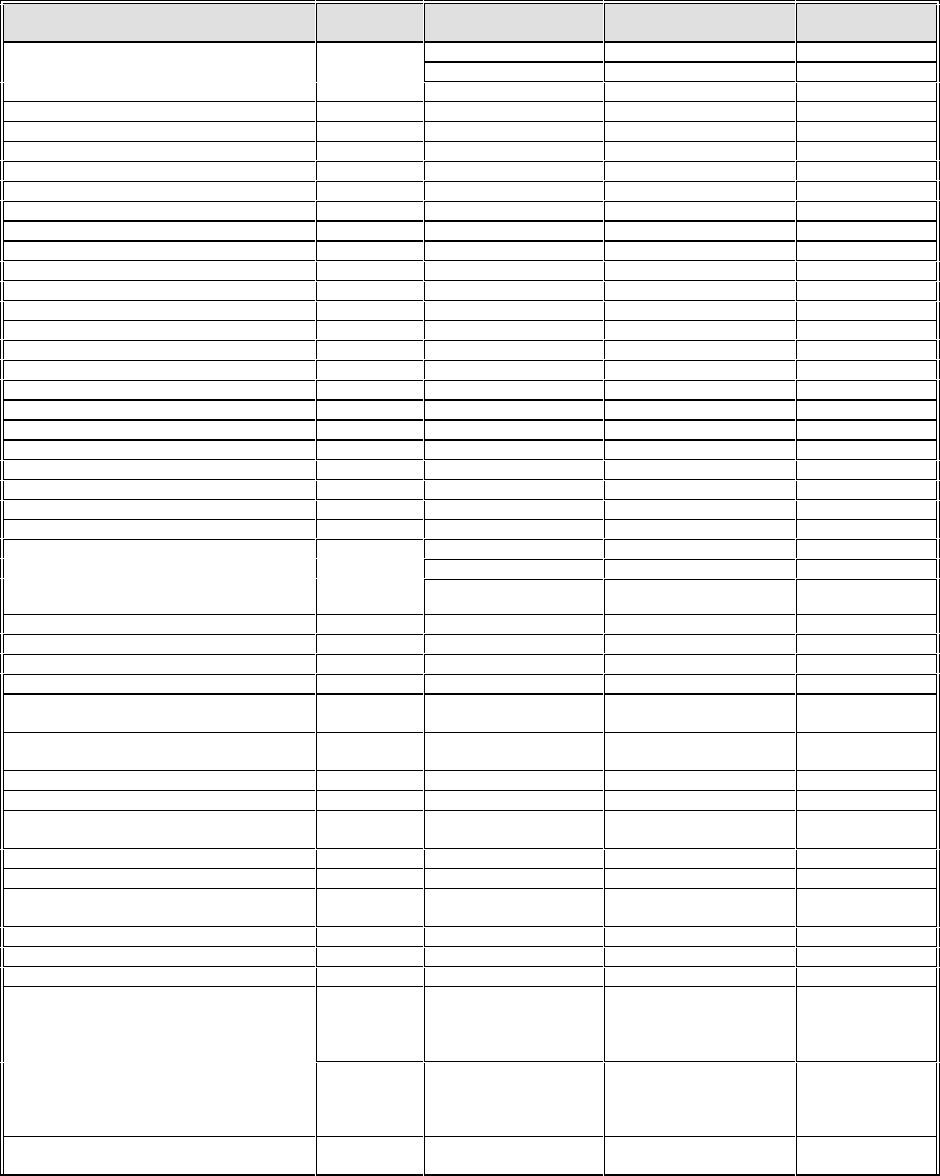
Chapter 15. Sewage Loading Criteria
[formerly Chapter 13 Appendix B]
§1501. General Requirements
A. See Note (a)
Place
Loading
Daily Average Flow
Gallons per Day
Daily Average BOD
5
Pounds per Day
Design Basis
Apartments
250
0.425
one bedroom
300
0.52
two bedroom
400
0.68
three bedroom
Assembly
Note (b)
2
0.0034
per seat
Bowling Alleys (no food service)
Note (b)
75
0.13
per lane
Churches
Note (b)
5
0.0088
per sanctuary seat
Churches (with permitted kitchens)
Note (c)
10
0.017
per sanctuary seat
Country Clubs
50
0.085
per member
Dance Halls
Note (b)
2
0.0034
per person
Drive-In Theaters
5
0.0085
per car space
Factories (no showers)
20
0.051
per employee
Factories (with showers)
35
0.06
per employee
Food Service Operations
Ordinary Restaurant (not 24 hour)
35
0.12
per seat
24-hour Restaurant
50
0.17
per seat
Banquet Rooms
5
0.017
per seat
Restaurant Along Freeway
100
0.33
per seat
Curb Service (drive-in)
50
0.17
per car space
Bar, Cocktail Lounges, Taverns
(no food service or very little food service)
25
0.084
per seat
(with regular food service)
35
0.12
per seat
Video Poker Machine
100
0.20
per machine
Fast Food Restaurants
40
0.13
per seat
Hotel/Motel Food Service
45
0.17
per room
Homes/Mobile Homes in Subdivisions
400
0.68
per dwelling
Individual Homes/Mobile Homes
(where individual sewage technology is
utilized. For each additional bedroom add
100 gpd)
250
0.425
one bedroom
300
0.51
two bedrooms
400
0.68
three bedrooms
Hospitals (no resident personnel)
Note (c)
200
0.51
per bed
Institutions (residents)
Note (c)
100
0.25
per person
Municipalities
100
0.17
per person
Mobile Home Parks
up to 5 trailer spaces
400
0.68
per mobile home
space
6 trailer spaces or more
300
0.51
per mobile home
space
Motels
Note (b)
100
0.12
per unit
Nursing and Rest Homes
Note (c)
100
0.25
per patient
100
0.17
per resident
employee
Office Buildings
20
0.051
per employee
Recreational Vehicle Dumping Stations
Consult OPH
Recreational Vehicle Parks and Camps
125
0.21
per trailer or tent
space
Retail Store
20
0.034
per employee
Schools―Elementary
Note (c)
15
0.038
per pupil
Schools―High and Junior High
Note (c)
20
0.051
per pupil
Retail Fuel Stations
(Located on major highways, etc., and whose
primary function is to provide fuel and
service to motor vehicles)
Note (d)
250
0.43
per individual
vehicle fueling
point (up to the
first four)
125
0.21
for each
additional
individual vehicle
fueling point
Shopping Centers
(no food service or laundries)
0.2
0.00034
per square foot of
floor space
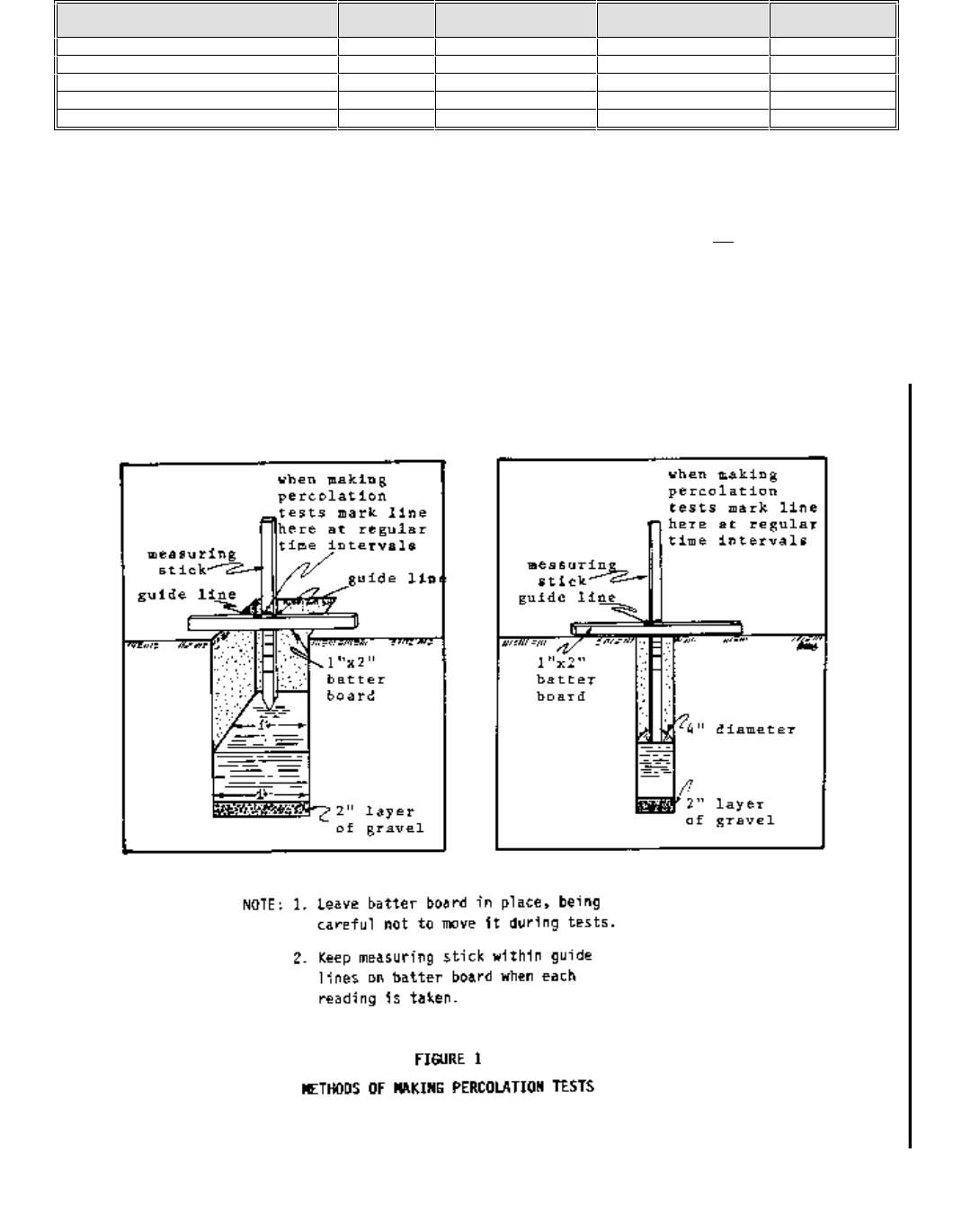
Place
Loading
Daily Average Flow
Gallons per Day
Daily Average BOD
5
Pounds per Day
Design Basis
Swimming Pool (including employees)
10
0.017
per swimmer
Showers
20
0.04
per shower
Vacation Cottages
50
0.12
per person
Youth and Recreation Camps
Note (c)
50
0.12
per person
Washing Machines
400
1.34
per machine
1. Note (a) If loading criteria other than presented here are used, they should be justified.
2. Note (b) Food Service waste not included.
3. Note (c) Food Service waste included but without garbage grinders.
4. Note (d) Vehicle fueling points are an arrangement of gasoline or diesel fuel pumps to serve automobiles or other vehicles. For the
purposes of these guidelines, a vehicle fueling point is one that serves a vehicle at one time. Food service waste not included.
Note: Design calculations for sewage treatment facilities must be made based on both hydraulic loading(s) and organic loading(s).
Final design of facility to be used upon the larger capacity (size) required by these calculations.
B. Figures
1. Methods of Making Percolation Tests
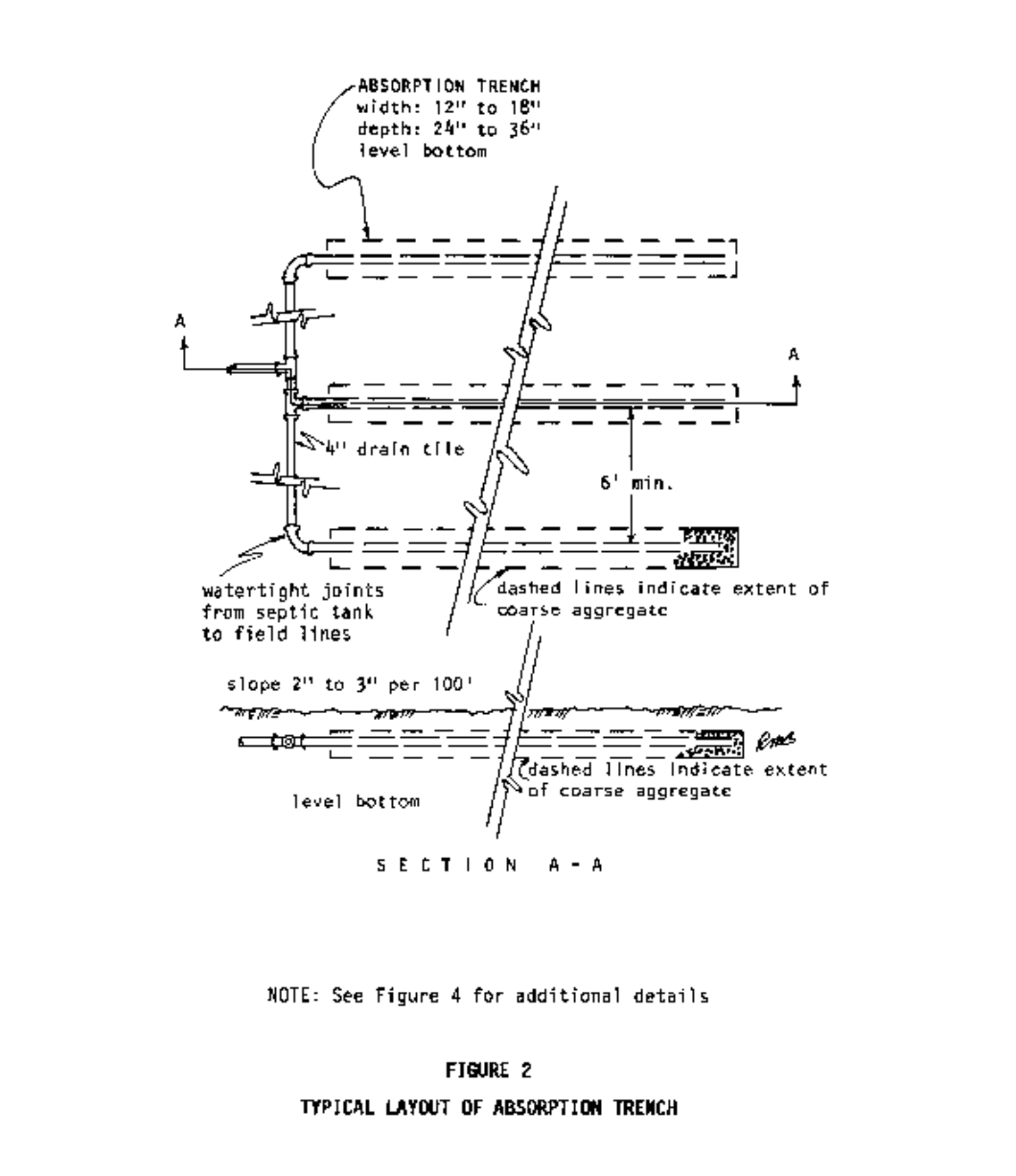
2. Typical Layout of Absorption Trench
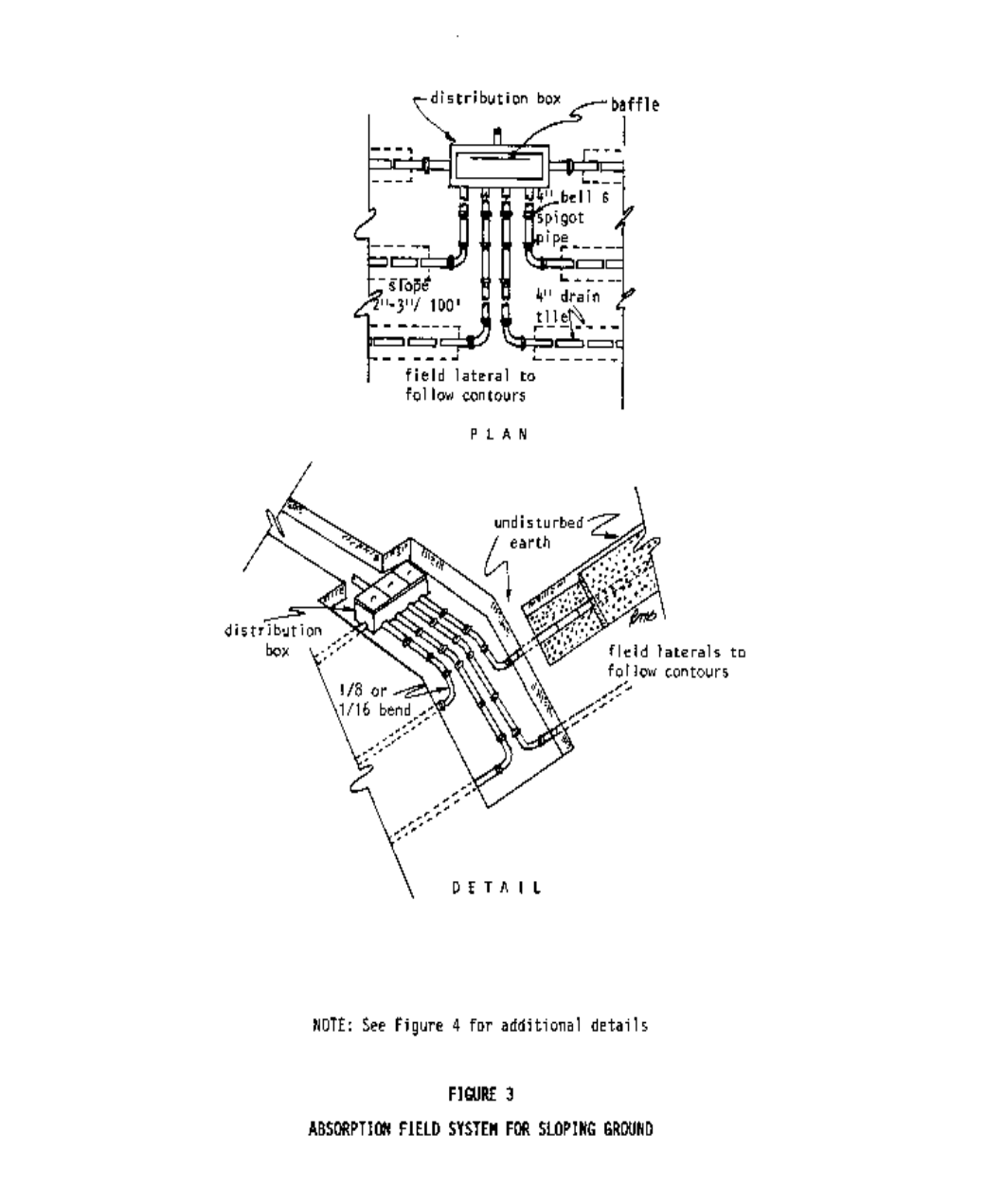
3. Absorption Field System for Sloping Ground
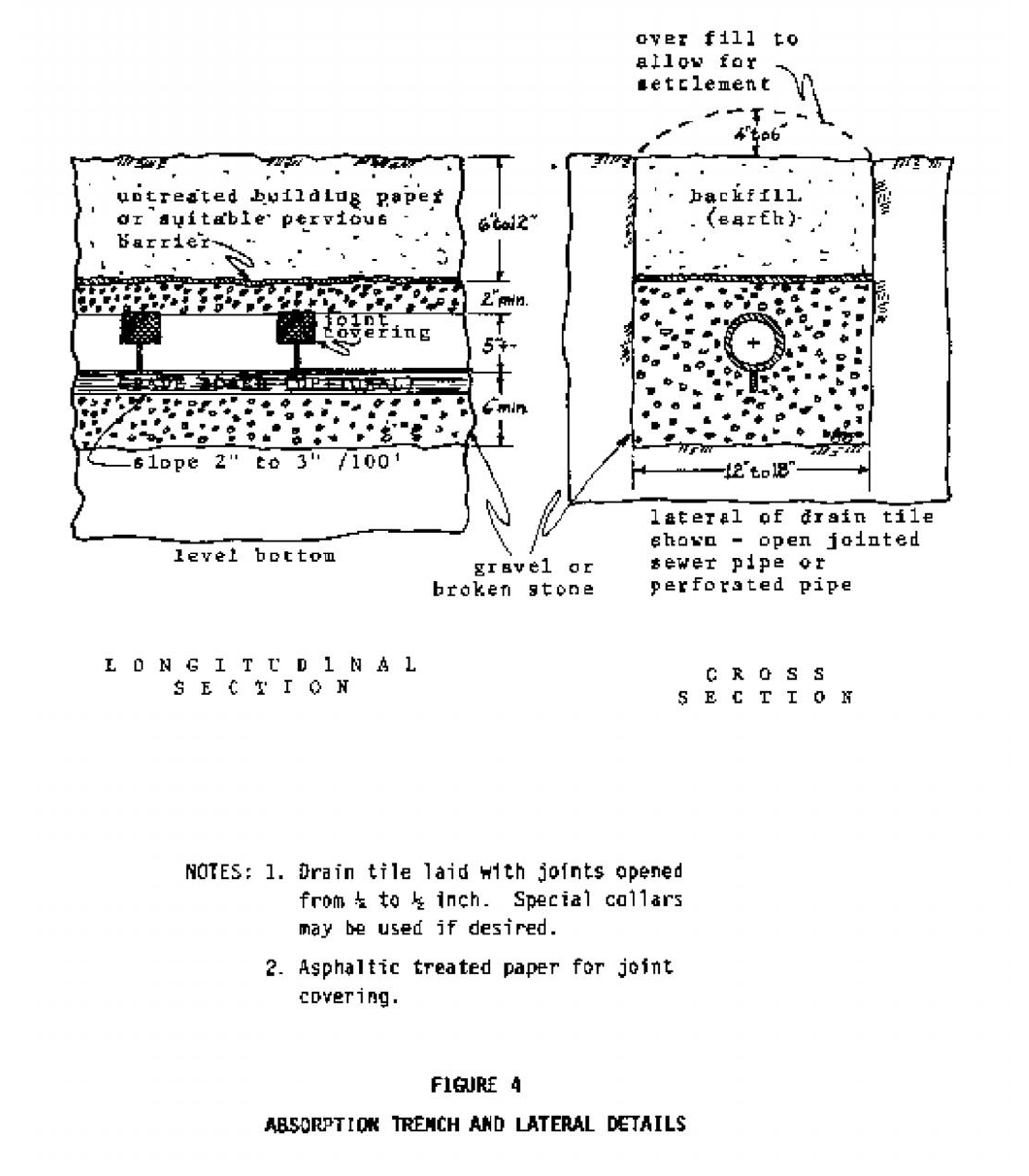
4. Absorption Trench and Lateral Details
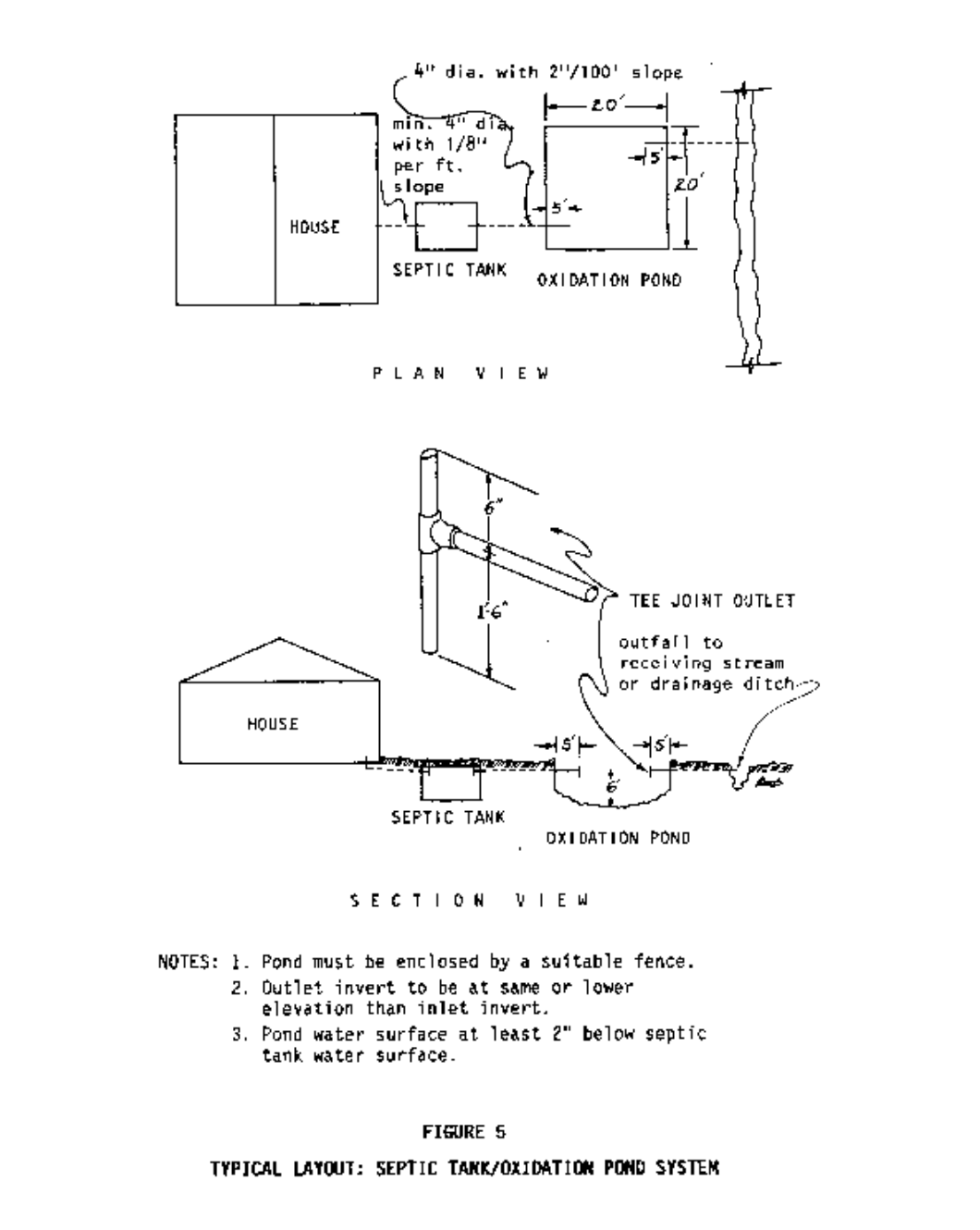
5. Typical Layout: Septic Tank/Oxidation Pond System
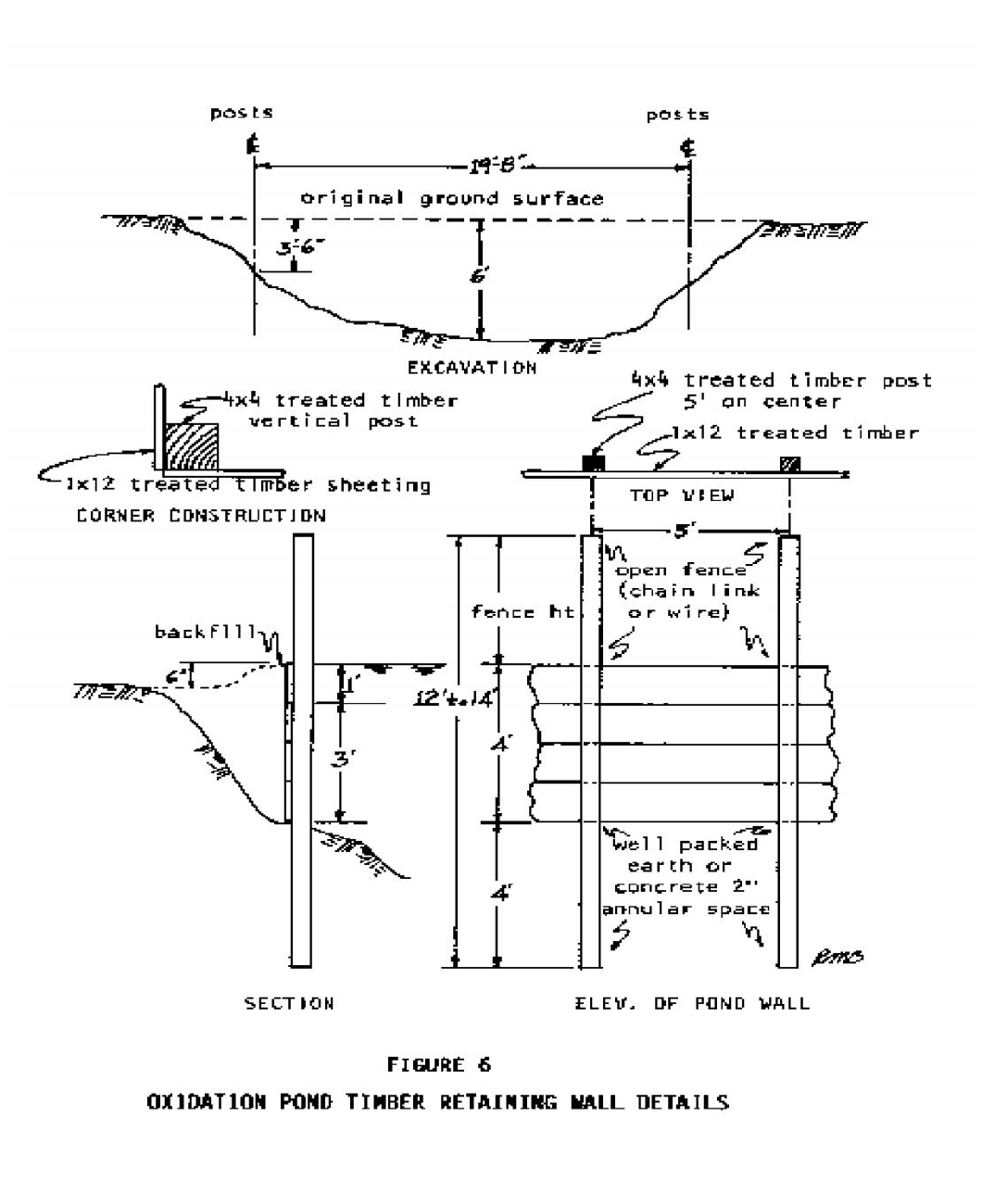
6. Oxidation Pond Timber Retaining Wall Details
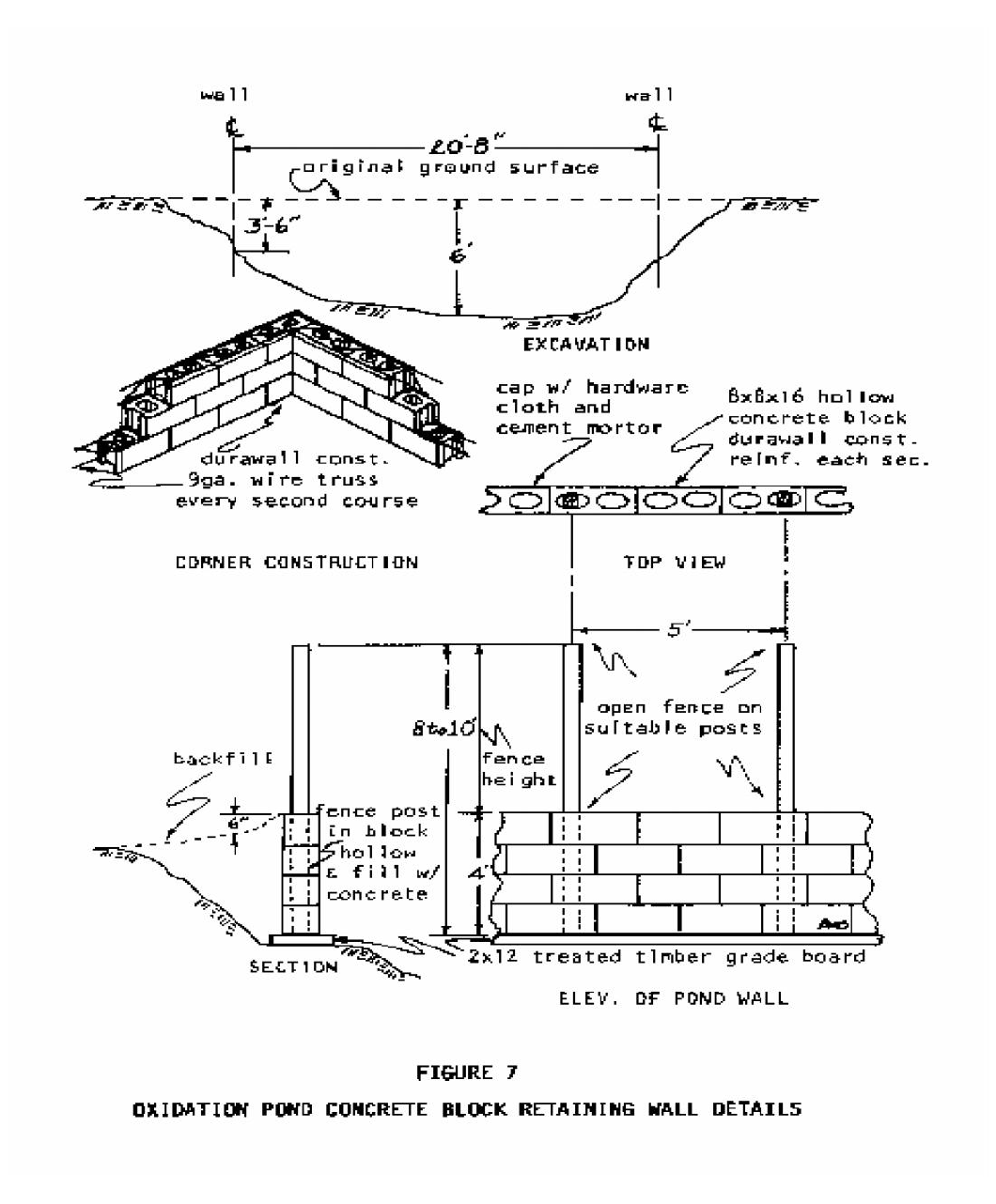
7. Oxidation Pond Concrete Block Retaining Wall Details
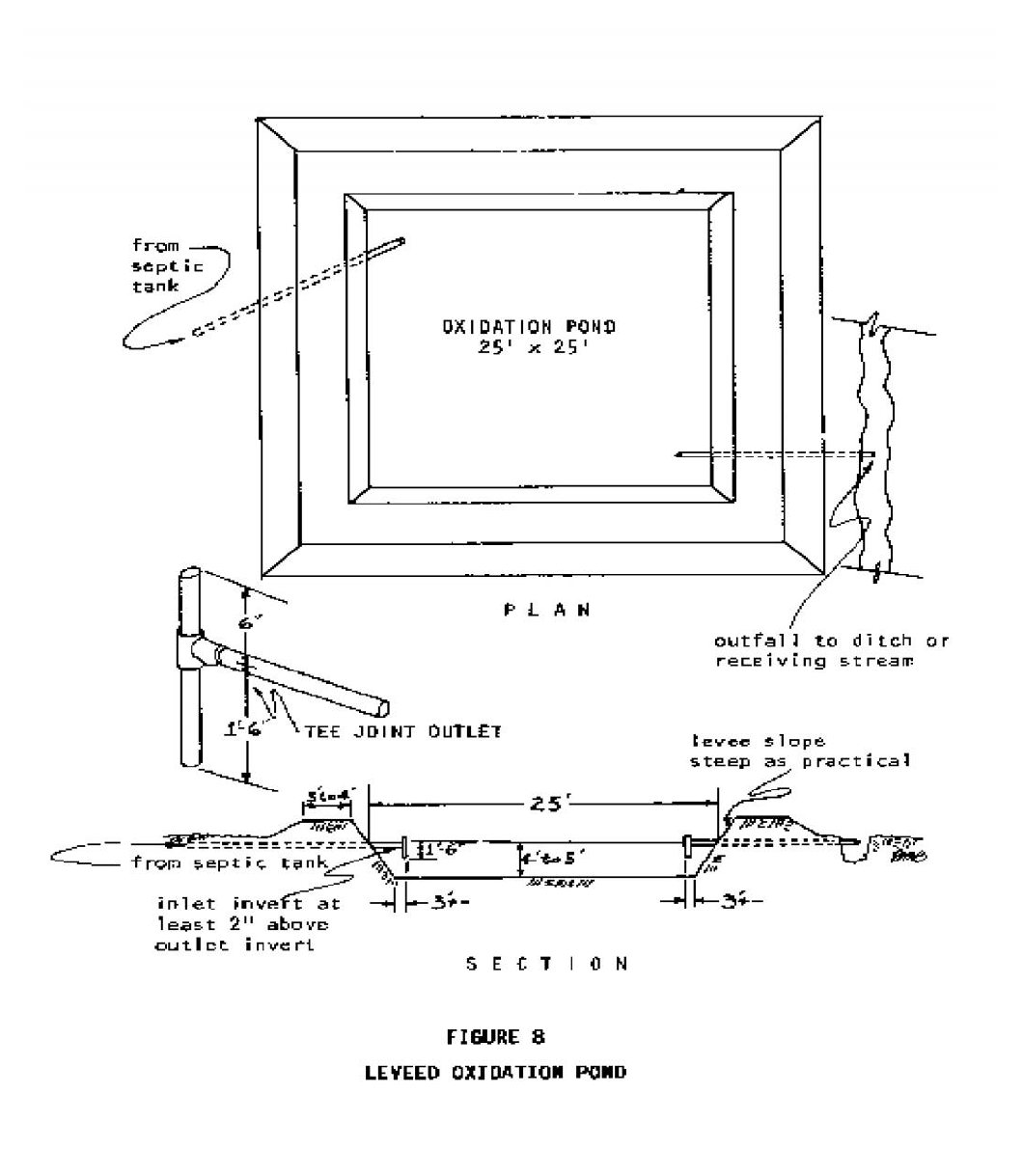
8. Leveed Oxidation Pond
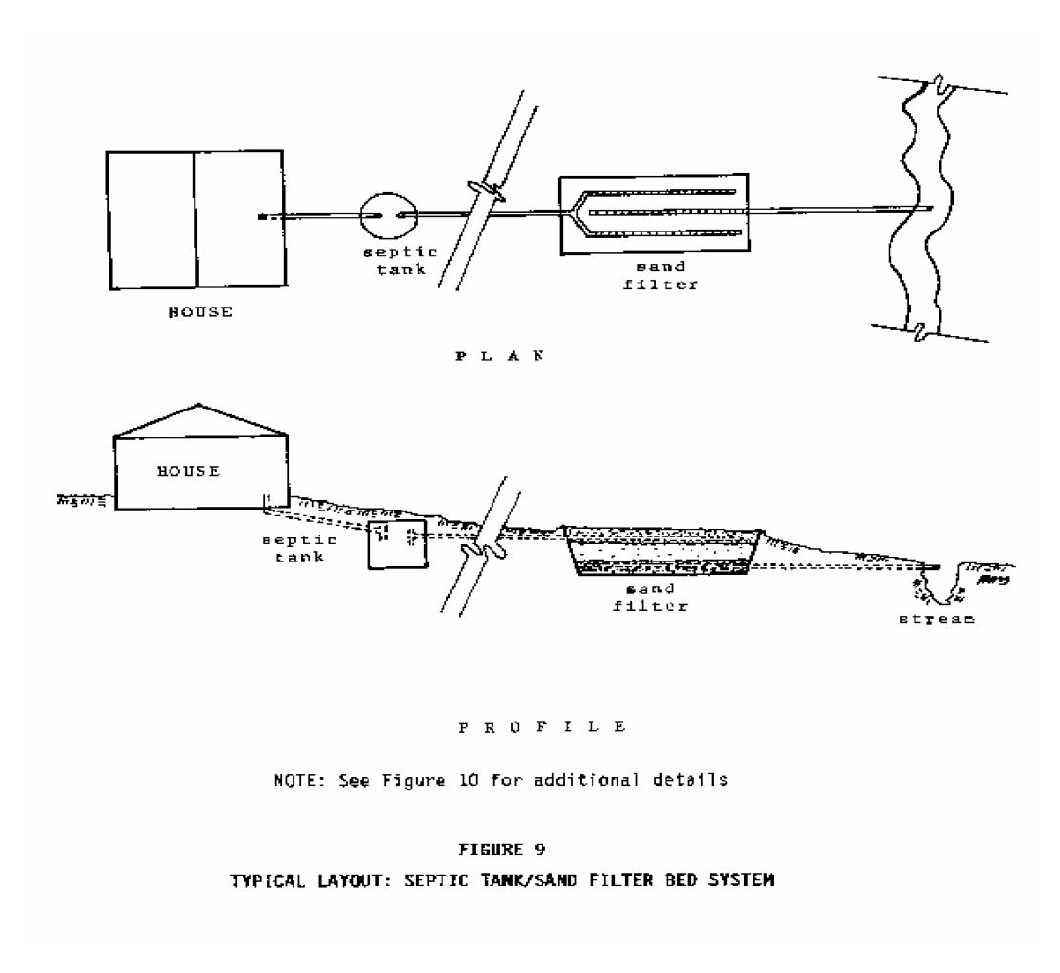
9. Typical Layout: Septic Tank/Sand Filter Bad System
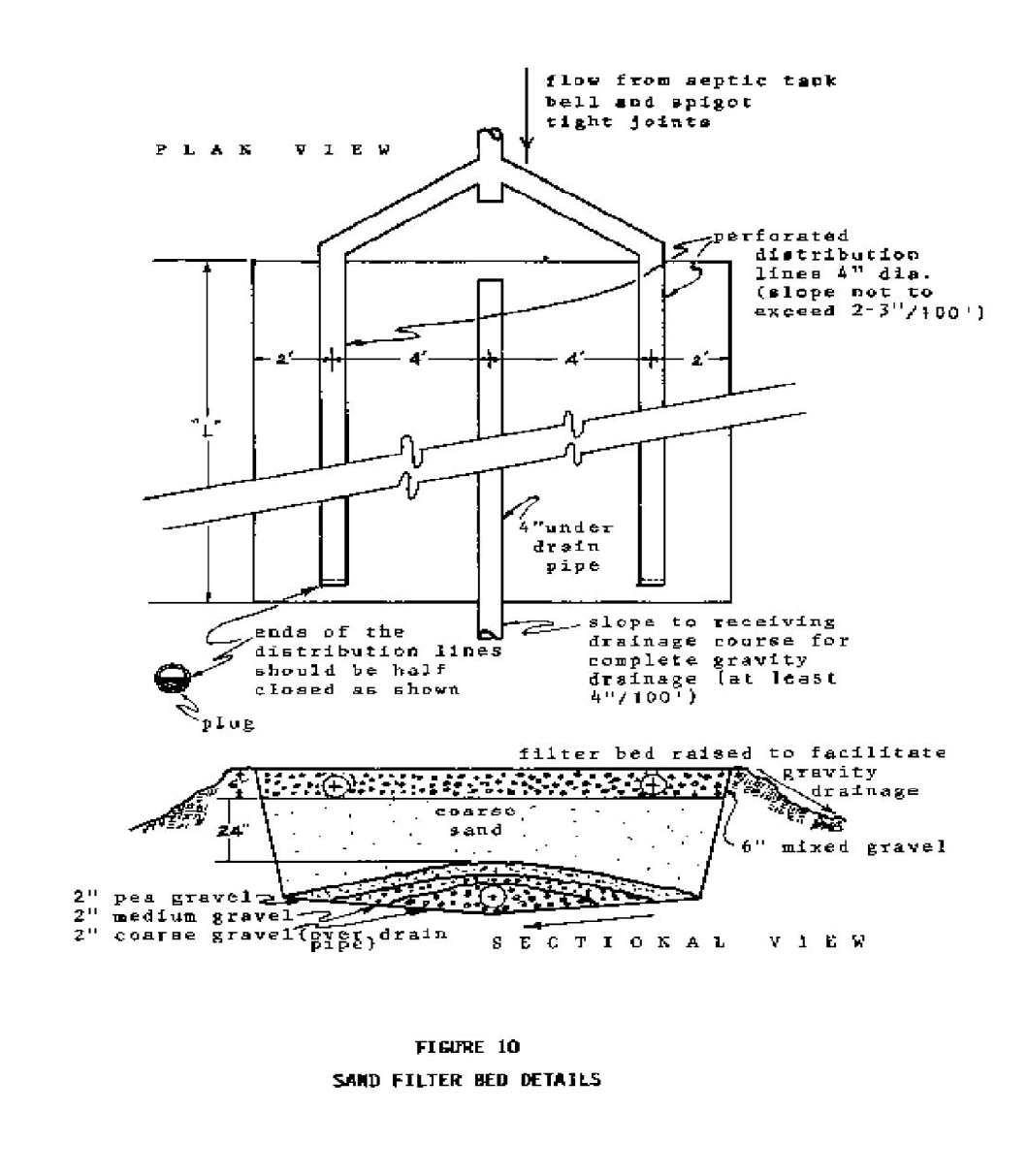
10. Sand Filter Bed Details
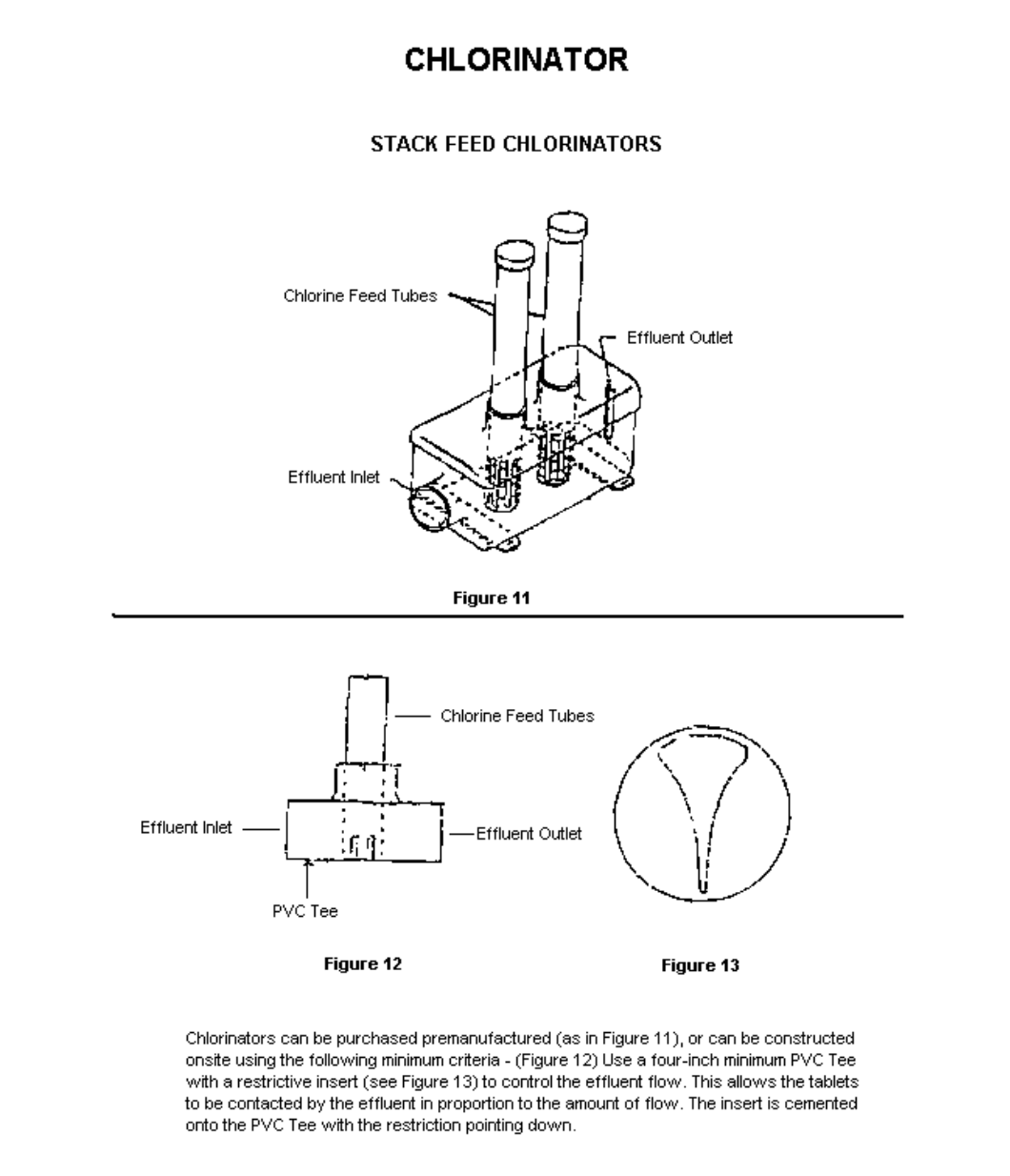
11. Chlorinator
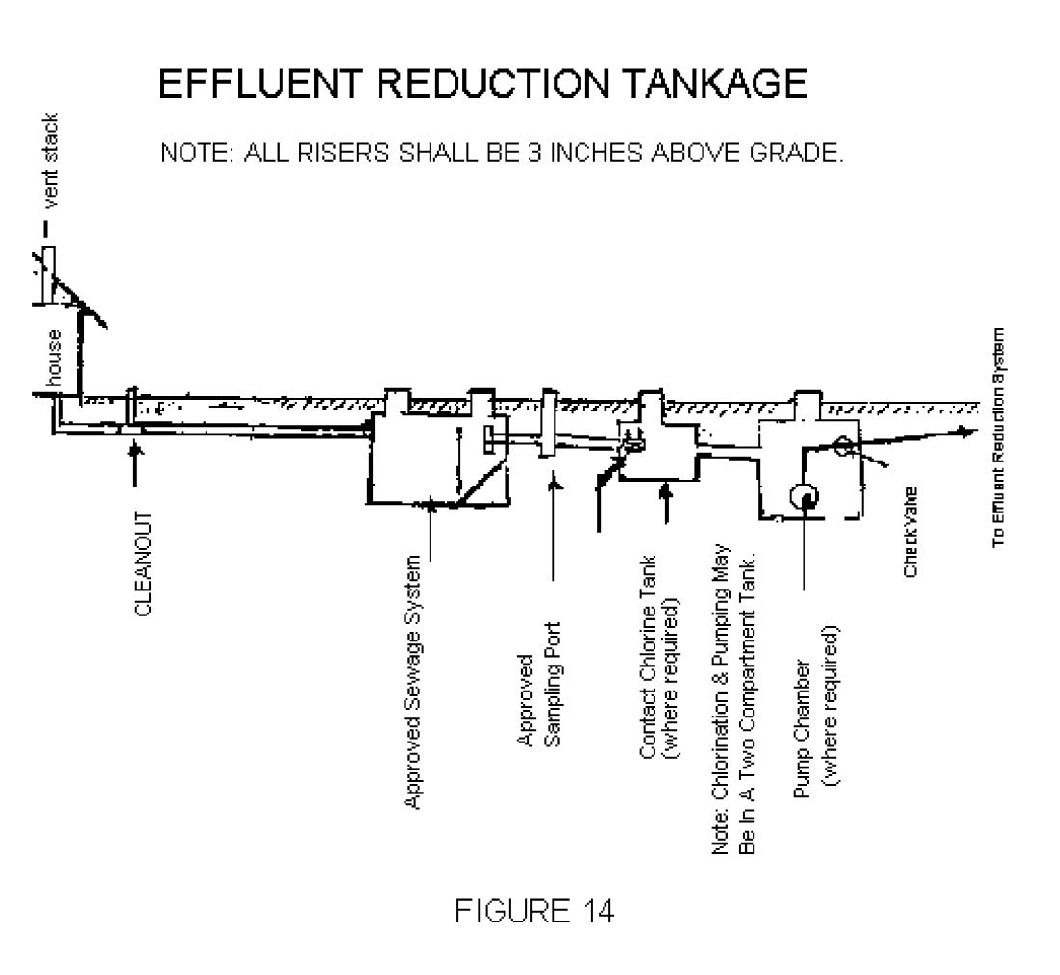
12. Effluent Reduction Tankage
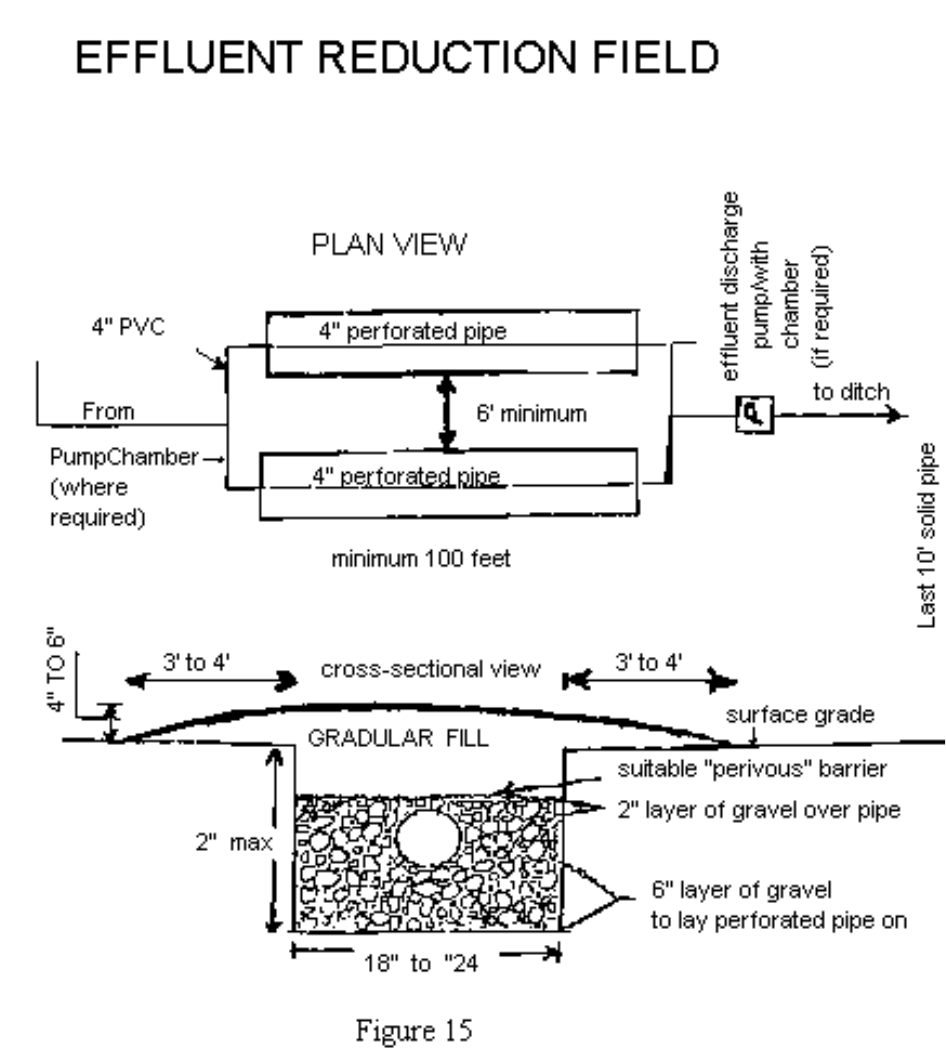
13. Effluent Reduction Field
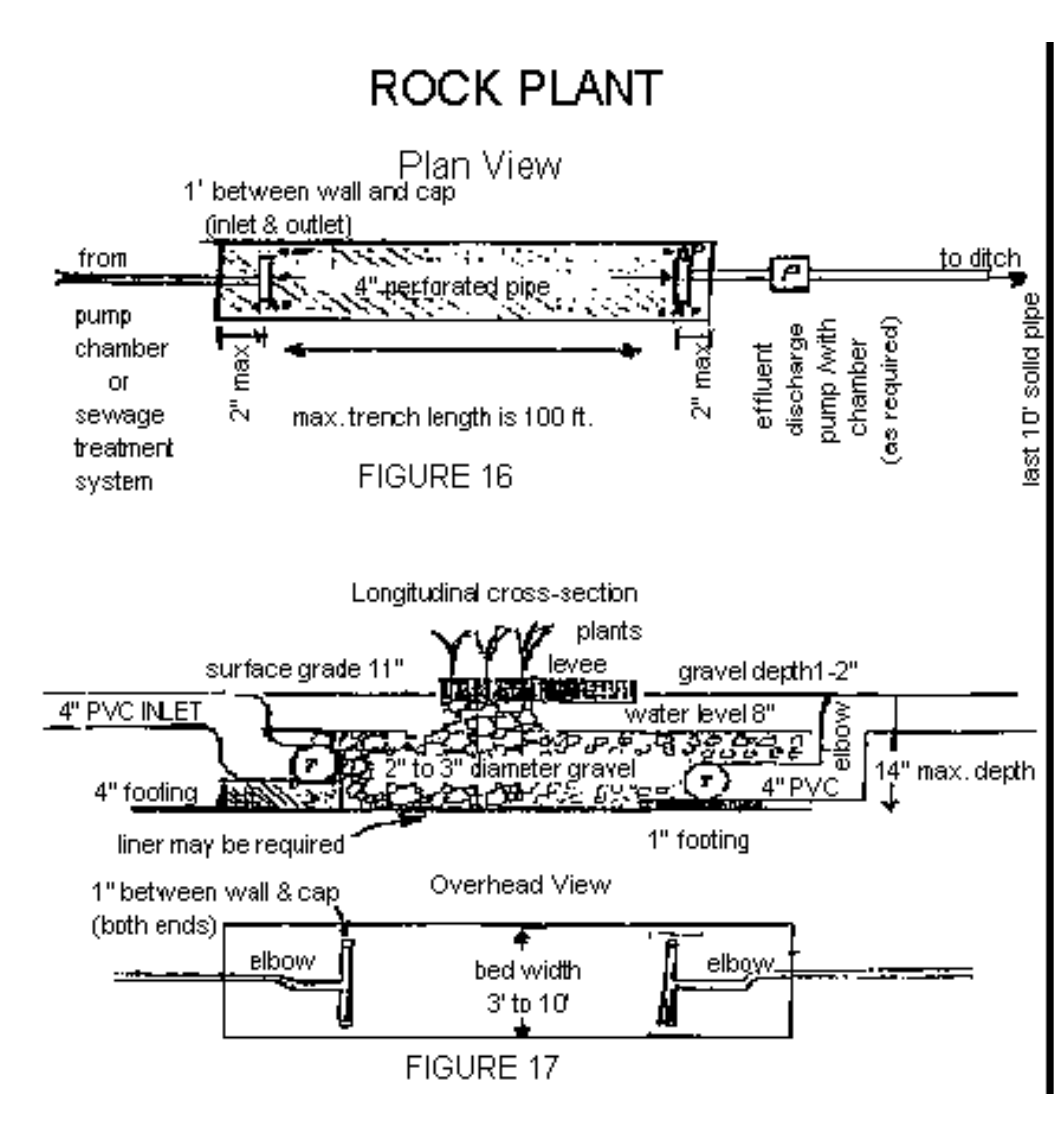
14. Rock Plant
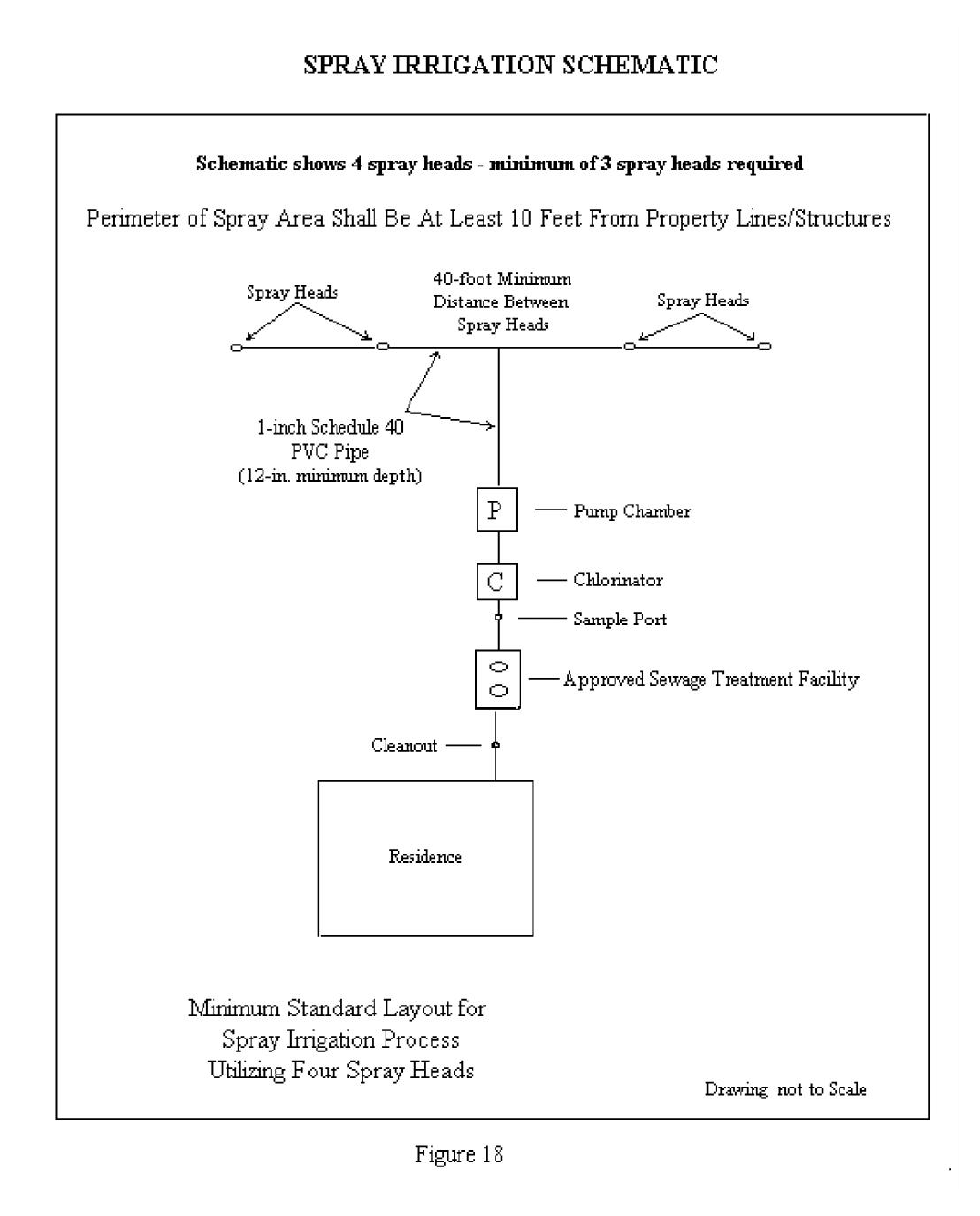
15. Spray Irrigation Schematic
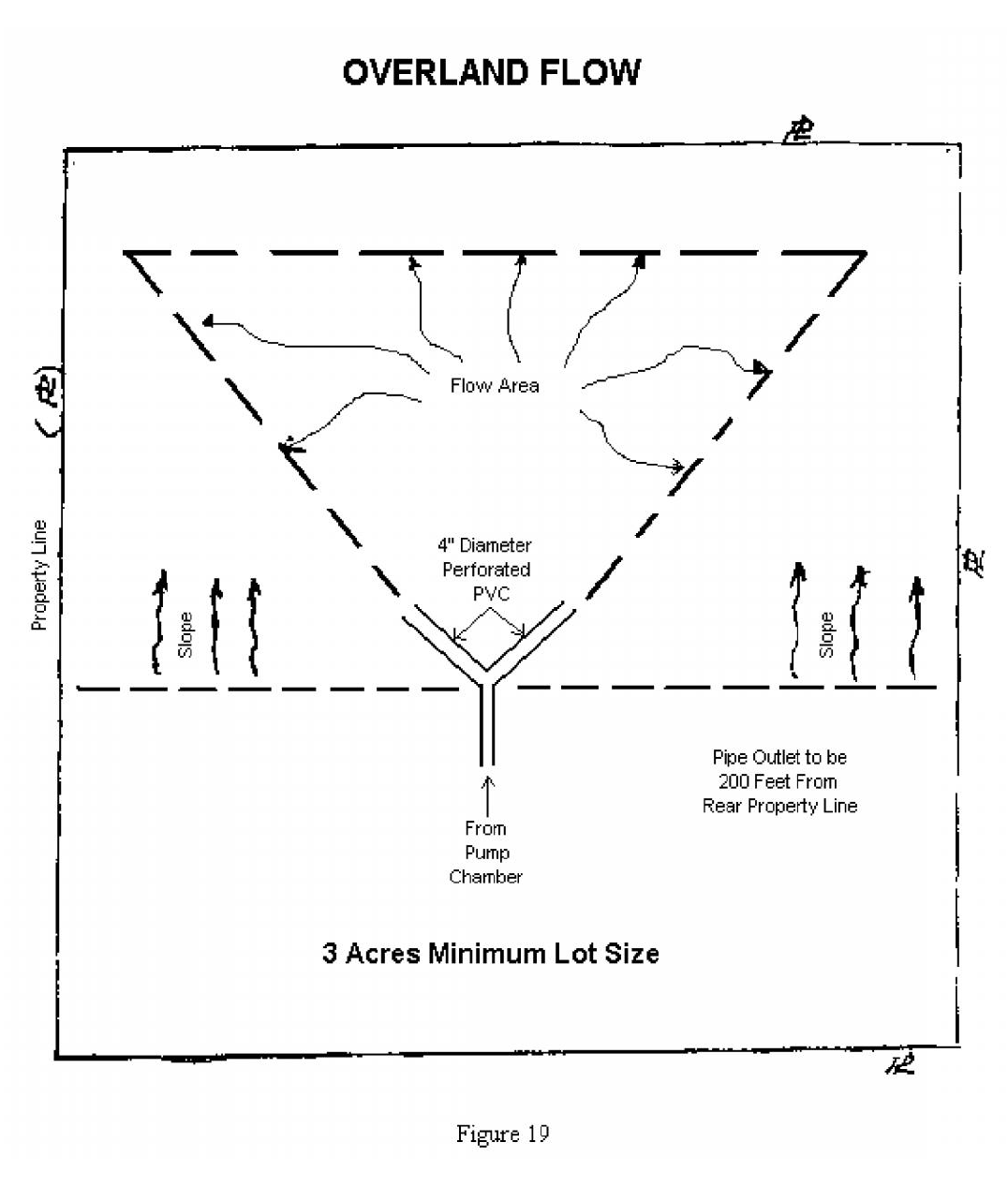
16. Overland Flow
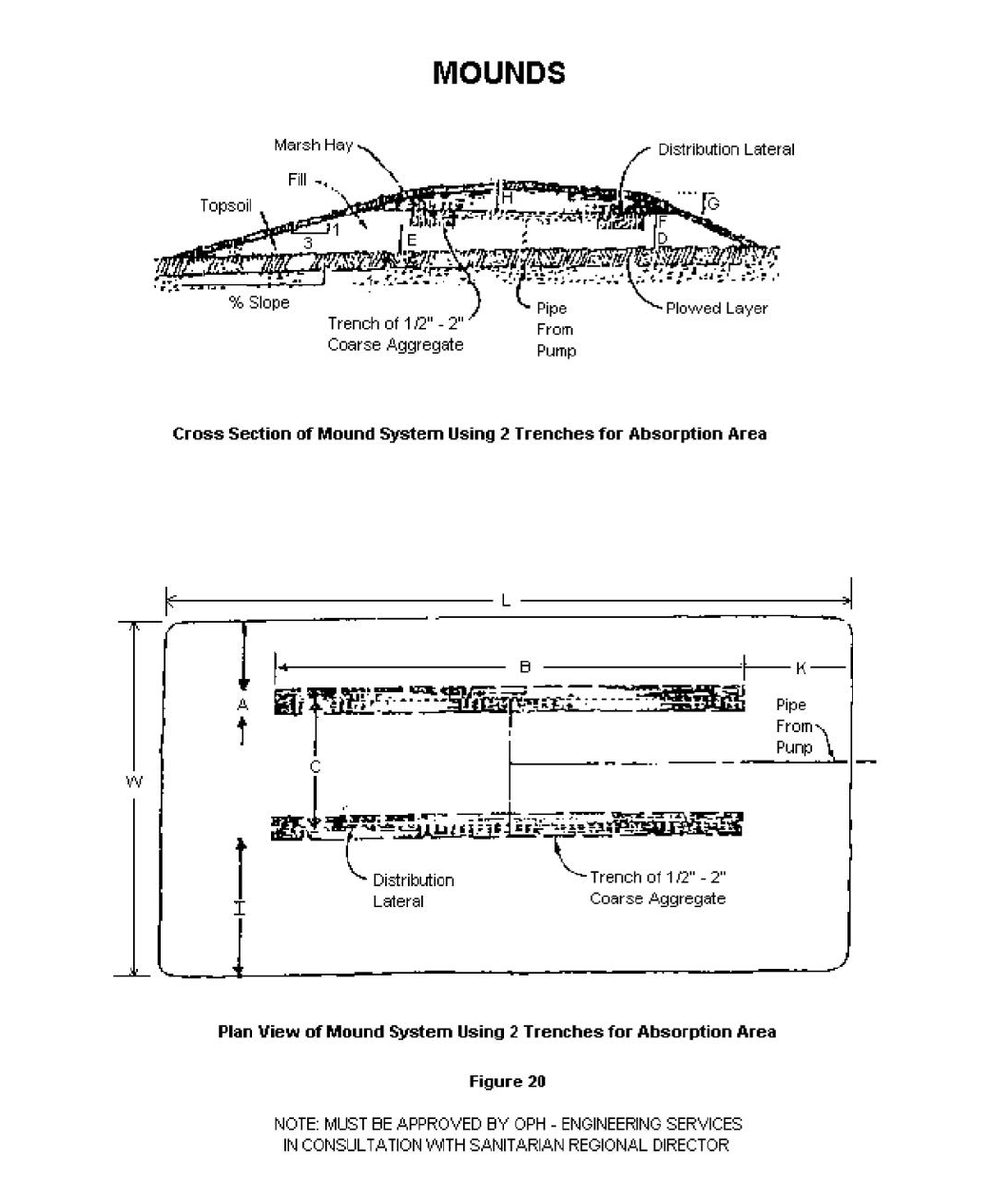
17. Mounds
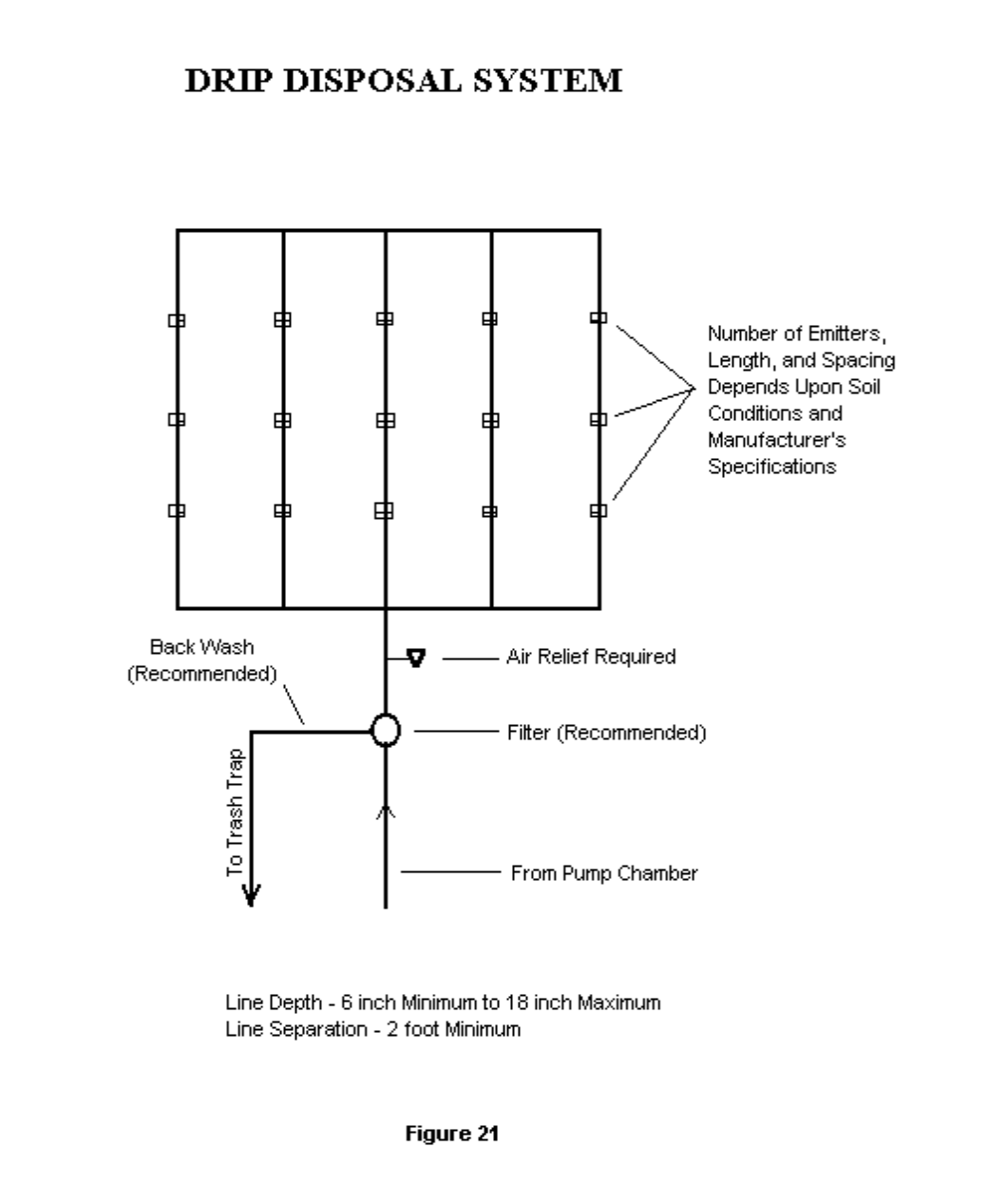
18. Drip Disposal System
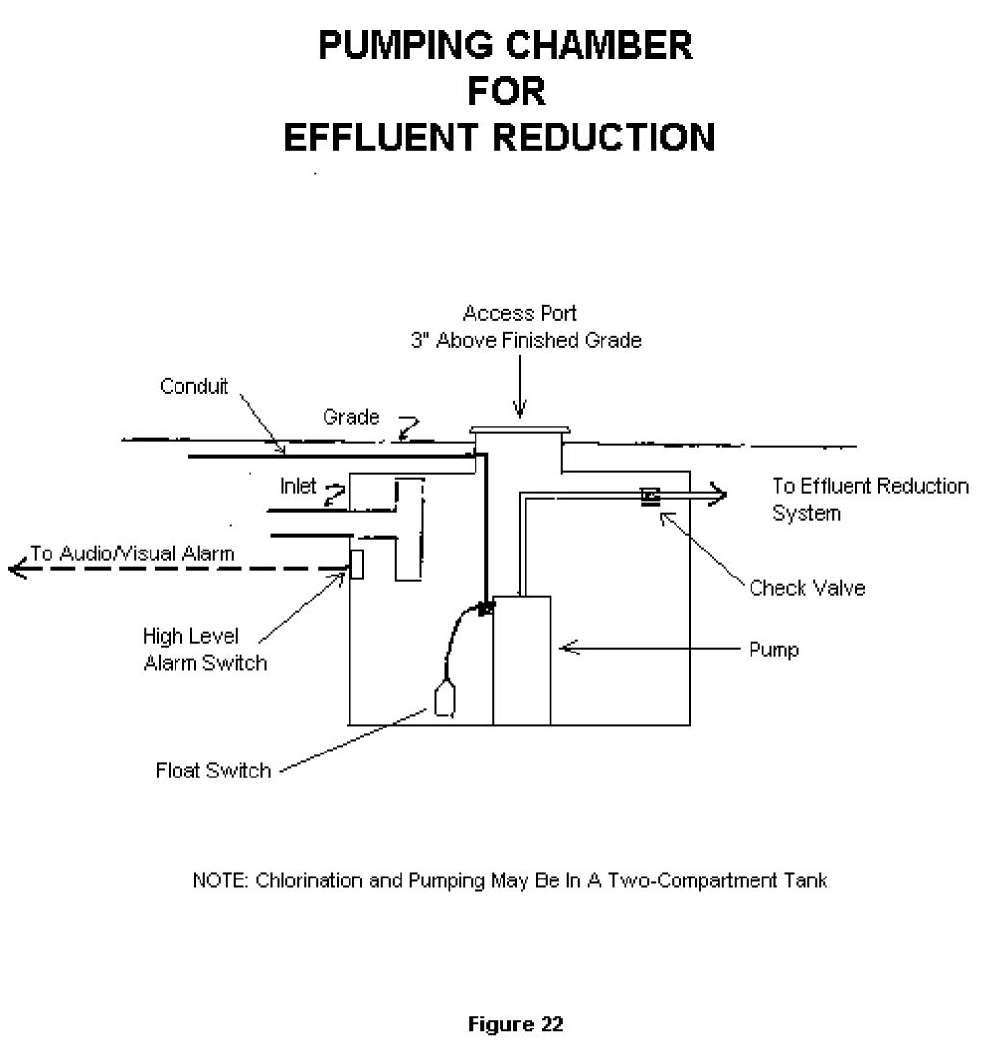
19. Pumping Chamber for Effluent Reduction
AUTHORITY NOTE: Promulgated in accordance with R.S.
40:4(A)(6) and R.S. 40:5(9)(20).
HISTORICAL NOTE: Promulgated by the Department of Health
and Hospitals, Office of Public Health, LR 28:1362 (June 2002).
